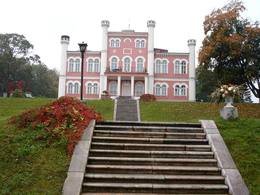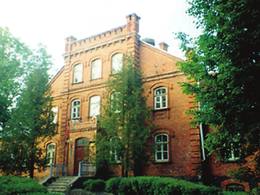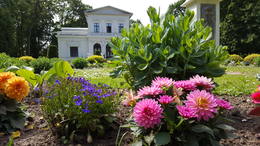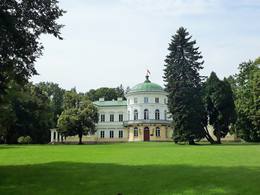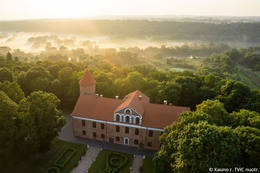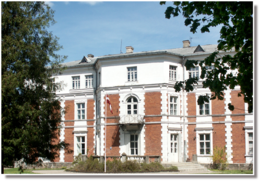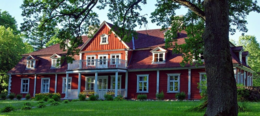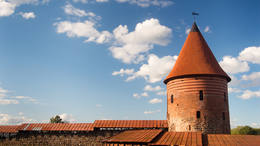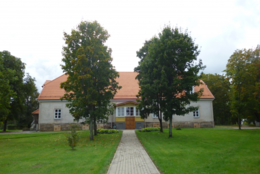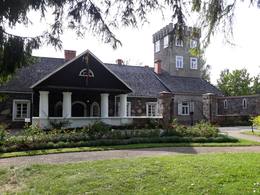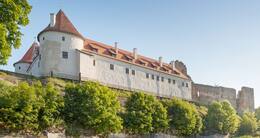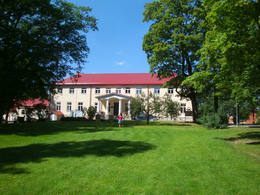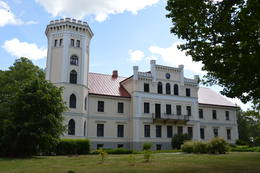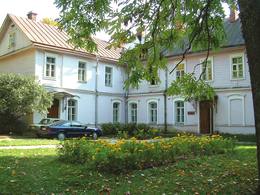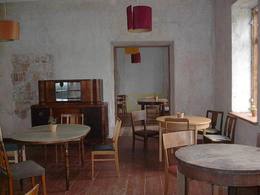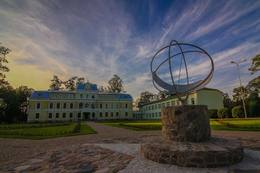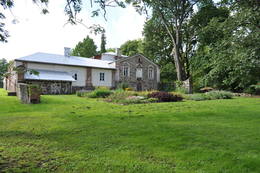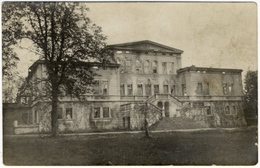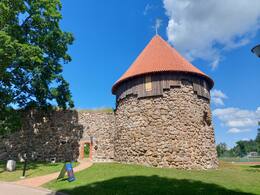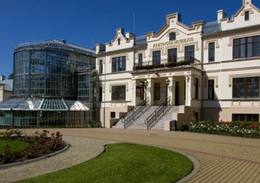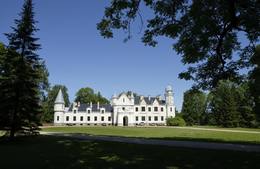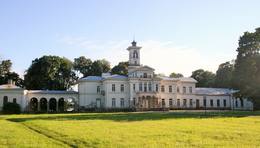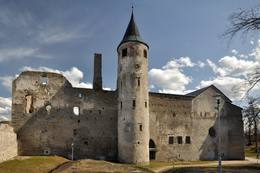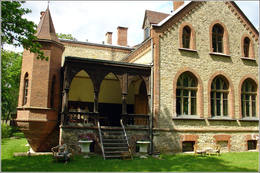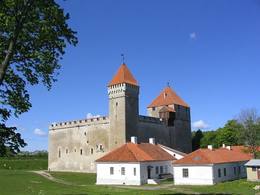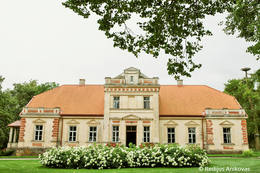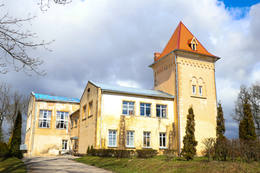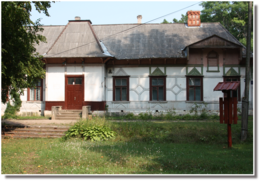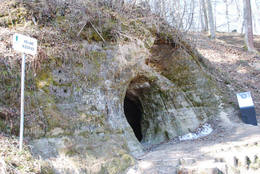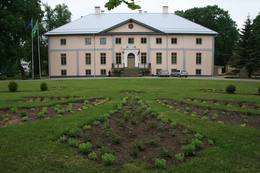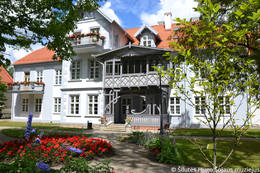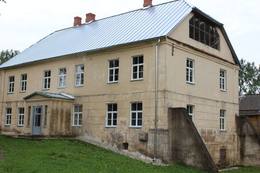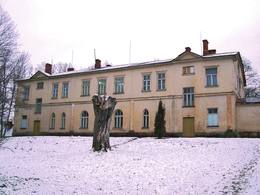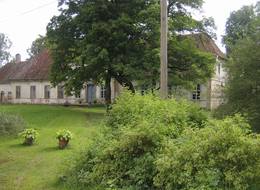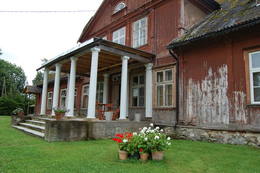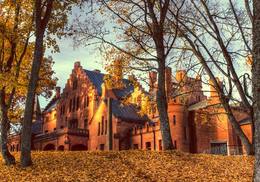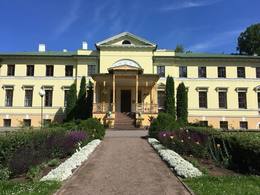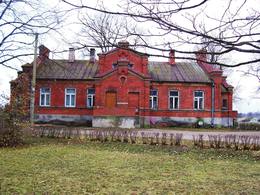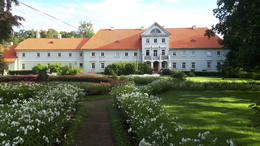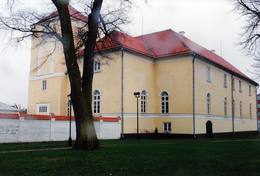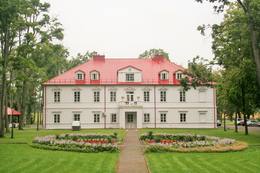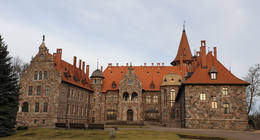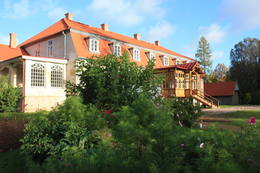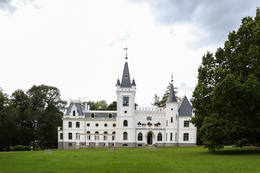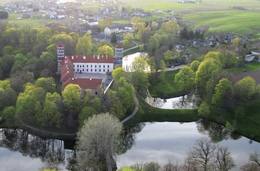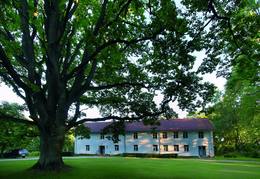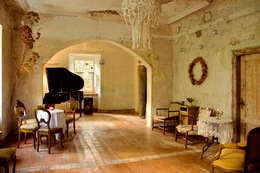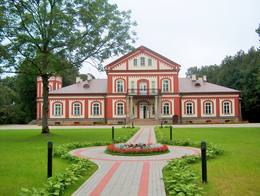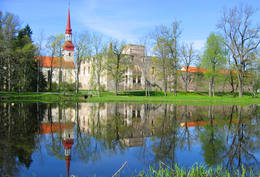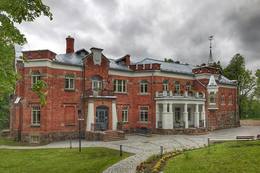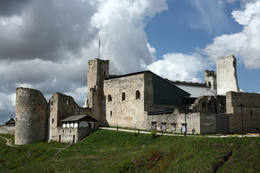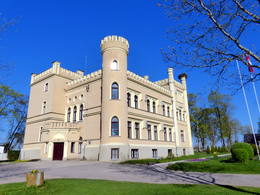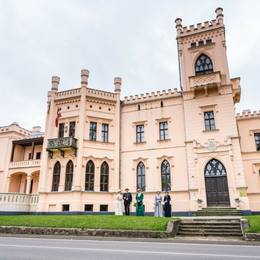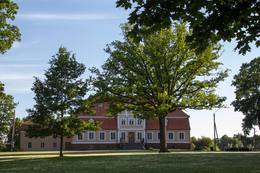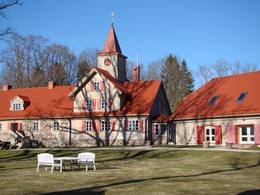Burgen und Herrenhäuser
| Überblick | Details |
|---|---|
|
Lettland
Schloss von BiriniDas Schloss von Bīriņi ist von 1857 bis 1860 als der Besitz der Grafen von Pistolkors gebaut worden. Das neogotische Schloss wurde von dem Architekten aus Riga Friedrich Wilhelm Hess projektiert. Man kann Informationen darüber finden, dass nach dem Bau des Schlosses es das prachtvollste und modernste Historismus-Gebäude in der Region Vidzeme war. Den Schlosskomplex bilden ein großer Park und ein Waldpark aus dem 19. Jh. mit Anpflanzungen von ausländischen Pflanzenarten, der künstlich gebildete See Bīriņu ezers, die im Jahr 1814 gebaute Gruft mit dem Grabstein der Grafen von Mellin (um 1835), eine Wassermühle, das Haus des Verwalters, Pferdeställe und andere Gebäude. An dem Schloss sind Obelisken aufgestellt, die A. Pistolkors und N. Pistolkors gewidmet sind. Bis heute hat sich in dem Schloss die wertvolle dekorative Innenausstattung aus dem 19. Jh. erhalten. Das Schloss von Bīriņi wurde am Anfang des 20. Jhs. laut den Plänen des Architekten Rudolf Heinrich Zirkwitz umgebaut. Von 1926 bis 1995 befand sich in dem Schloss ein Sanatorium. Heute werden in dem Schlosskomplex verschiedene Veranstaltungen organisiert, hier befinden sich ein Hotel, ein Restaurant und ein Museum. |
|
|
Lettland
Rikavas ManorRikavas Manor is the local architectural monument that belonged to Janovski family. Michael Riks
bought the building in the second half of the 18th century. The construction works of the manor house lasted
from 1870 till 1875. The redbrick building is an example of Neo Gothic style. Since 1926 there was established
a school. You should see the beautiful interior and wooden stairs as well as school’s workshop
|
|
|
Litauen
SCHLOSSPARK SVĖKSNADer Komplex des Schlosses Švėkšna ist einer der schönsten in ganz Niederlitauen. Neben dem Schloss befindet sich der eindrucksvolle Schlosspark. Beide Teile des Parks werden durch eine breite Freitreppe, von der sich eine wunderbare Sicht auf die Gewässer des Parterres eröffnet, verbunden. Auf der Insel des zentralen Schlossteichs Švėkšna steht noch immer die Skulptur der Göttin Diana. Auf der Hauptallee des Parks wurden die prächtige Sonnenuhr, die Vase auf Podest, die Marienskulptur und der „Freiheitsengel“ wiederhergestellt. Auch andere Elemente des Parks wurden mittlerweile restauriert: der Aussichtspunkt, Wege und Tore. |
|
|
Litauen
SCHLOSSPARK BAISOGALADas Gut Baisogala zählt zu den ältesten in Litauen und wurde als königliche Domäne bezeichnet, das es dem litauischen Großfürsten gehörte. Das prächtige Herrenhaus stammt in seiner heutigen Form aus der Mitte des 19. Jahrhunderts im Stil des Spätklassizismus (Empire). Der 12 ha große Landschaftspark wurde in der ersten Hälfte des 19. Jh. angelegt. Zur Stadt hin führt eine Kastanienallee. Ab dem Haupttor führt die gewundene Allee zwischen zwei Teichen hindurch über eine Brücke mit Löwenfiguren. Hinter dem Herrenhaus beschatten Bäume verschiedenster Arten die gewundenen Wege und schmale Pfade. Beidseitig der Hauptallee befindet sich je ein Teich. Ein dritter Teich mit Insel findet sich am anderen Ende des Parks. |
|
|
Litauen
SCHLOSSPARK RAUDONDVARISDas Schloss (mitunter auch Burg) Raudondvaris steht am rechten Ufer des Nevėžis in Raudondvaris. Das Schloss bildet zusammen mit dem 3,8 ha großen Park, den beiden Gesindehäusern, dem Marstall und dem Eiskeller ein einheitliches architektonisches Ensemble. Neben dem Schloss wurde 1834 der Schlosspark angelegt, rekonstruiert im 20. Jh. Auf dem Gelände des Parks wurden die Grünanlagen und die Blumenrabatten erneuert. Besonders ragen die in den Park zurückgeführten alten Rosensorten hervor. Der nördliche Rand des Parks geht allmählich in Wald über. Hier wachsen Rotahorn, Weymouthskiefer, Krim-Linde und im Frühling erblüht Edelweiß. Einige Pfade des Parks führen zum Landschaftsschutzgebiet Nevėžis. |
|
|
Lettland
Landgut von BebreneDer Landgutkomplex von Bebrene(im Stil Barock) hat sich vom Ende des 19. Jhs. bis zum Anfang des 20. Jhs. gebildet. Die Dominante des Komplexes ist das im Jahr 1896 gebaute (Architekt L. J. L. Marconi) Schloss der Grafen Plater-Sieberg, in dem heute das Gymnasium von Bebrene haust. Bis heute haben sich ein prachtvolles Tor und ein ungewöhnlich aussehender gemauerter Zaun erhalten. Das Landgut wird von einem Park mit einem symmetrisch angelegten Parterre und mit reichlichen Anpflanzungen von ausländischen Baumarten eingeschlossen. |
|
|
Lettland
The Birzi Manor ComplexThe manor is in Basi in the Gudenieki Parish of Kuldīga District, some 20 km from the district centre. The manor was built in the 19th century, burned down in 1905, and then restored. A former residence for servants and an old magazine barn have survived. The surrounding park covers 4.5 ha, and the estate is a cultural and historical monument of local importance. The barn was fully reconstructed in 2009 and 2010 with co-financing from the European Union, and today it is the Basi Culture Centre. In 2019, there is to be an interactive exhibition about Suiti events in Gudenieki -- baptisms, weddings, funerals, etc. |
|
|
Lettland
Riebinu muizaŠī vairāk ir uzskatāma par vēsturisku vietu, nekā tūrisma objektu, jo muižas pils atrodas avārijas stāvoklī un apskatāma no ārpuses! Mūsdienās redzamais muižas komplekss ir veidojies 19. - 20. gs. mijā, bet muižas pils (vēlīnais klasicisms) - 19. gs. pirmajā pusē. Vēlāk tai piebūvēja neobarokālus torņus abos ēkas galos. Vienā no tiem atradās kapela, otrā – bibliotēka. 19. gs. tika uzsākta ainavu parka un dendrārija izveide. 19. gs. beigās pilī norisinājās plaši remontdarbi, un tās īpašnieki – Kerbedzu dzimta ēku līdz pat 1. pasaules karam atvēlēja māksliniekiem. No 1920. - 1975. g. muižā darbojās pamatskola, tad ēkas kā noliktavu izmantoja kolhozs. |
|
|
Lettland
Das Neue Schloss von SiguldaDieses Schloss wurde von 1878 bis 1881 (Baumeister Jānis Meņģelis; deutsch ist Sigulda Segewold) gebaut. Der Inhaber war der Fürst Kropotkin. Im Jahr 1937 wurde der Schlossturm erhöht (Architekt Alfrēds Birkhāns). Von 1923 bis 1940 befand sich in dem Gebäude das sogenannte Schloss der Schriftsteller (die Wirtschaft hat hier damals die Lettische Pressegesellschaft geführt), aber während der Sowjetzeit – ein kardiologisches Sanatorium. Im Jahr 1993 zog in das Schloss die Stadtverwaltung von Sigulda ein, seit 2003 befindet sich hier die Kreisverwaltung von Sigulda. In dem Landgutkomplex haben sich ein Wohnhaus aus Holz (Mitte des 19. Jhs.), wo die Familie von Kropotkin wohnte, eine Kornkammer (Jahrhundertwende 18.-19. Jh.), ein Gartenhaus (19. Jh.) und ein gemauerter Zaun (19. Jh.) erhalten. Das Neue Schloss von Sigulda, genauso wie die Burgruinen von Sigulda und Krimulda, das Landgut von Krimulda und die Burg von Turaida gehören zum Komplex der historischen Zentren von Sigulda, Turaida und Krimulda. |
|
|
Lettland
UngurmuizaMuižas ēka tikusi restaurēta, taču tā celta 1732. gadā. Muižas kompleksu veido – kungu māja, bijušās skolas ēka, pārvaldnieka māja, klēts, saimniecības ēka, kā arī tējas namiņš, kas atrodas senajā ozolu parkā, no kura takas tālāk aizvijas uz Meža parku. Ungurmuižas iekštelpās ir grezni zīmējumi (grenadieri, ziedu motīvi, zīmētas tapetes, drapēri, ainas no barona karagājieniem un ceļojumiem) kuru autors ir Limbažu gleznotājs Georgs Dītrihs Hinšs. Ungurmuižā par seno auru rūpējas katrs gleznojums, zīmējums un katrs nostūris. |
|
|
Lettland
Lodes muizaLodes muižas ēkas izvietojušās t.s. Lodes – Taurenes subglaciālās iegultnes (cauri tek Gauja) austrumu nogāzē. Muižas apbūve tapusi 19. gs. pirmajā pusē, bet kungu māju (klasicisma stils) cēla 1815. g. Pēdējie īpašnieki, kas šeit saimniekoja (līdz 1939. g.) – bija Šmidtu dzimta. Mūsdienās muižas pilī vasarās dzīvo LU Ģeogrāfijas un Zemes zinātņu fakultātes studenti, kuriem šeit ir lauku prakšu norises vieta. Kungu māja apskatāma no ārpuses. |
|
|
Litauen
Kaunas CastleKaunas Castle is the oldest stone castle in Lithuania and interestingly enough, the museum that is inside is also the oldest one in Lithuania. It's possible to take a tour to get know more about Kaunas Castle and also visit the museum where there's not only information about the castle but also about the city of Kaunas itself and much more. |
|
|
Lettland
Der Gutshof Bikseres muizaDer Weg, der nach Biksere führt, erinnert an eine schmale Bergstraße mit einem tiefen Graben eines kleinen Flusses. Der frühere Namen von Biksere war Libes muiža (auch Lybei Hoff, Lybienhoff), die heute noch erhaltenen Gebäude gehörtem dem Gutsherrn Magnus. Der neogothische Turm des Herrenhauses wird in Kunstkenner-Kreisen als architektonische Kuriosität bezeichnet. Im Herrenhaus ist der Sitz der Gemeindeverwaltung von Sarkaņi. In der ehemaligen Scheune hat der Kunstliebhaber Andris Trečaks seine Antiquitätensammlung ausgestellt. Von der Scheune aus hat man einen wunderbar weiten Blick auf die tiefer gelegene Ebene von Lubāna. |
|
|
Lettland
Landgut von KrimuldaDas Landgut von Krimulda (deutsch Cremon) ist in den schriftlichen Quellen zum ersten Mal schon im 15. Jh. erwähnt worden. Das heutige Schloss von Krimulda erhebt sich prachtvoll gegenüber der Luftseilbahn von Sigulda auf dem Hang des rechten Grundufers des Urstromtales von Gauja. Sowohl auf das Schloss (vom anderen Ufer und von der Luftseilbahn), als auch aus dem Schloss eröffnet sich eine wunderschöne Aussicht auf das Urstromtal des Flusses Gauja. Das Schloss von Krimulda wurde im 19. Jh. im Neoklassizismus gebaut und sein Inhaber war der Fürst Lieven. In den 1920er Jahren gelang das Schloss nach der Enteignung im Eigentum des Lettischen Roten Kreuzes, das dort ein Sanatorium für Kinder eingerichtet hat. Heute befindet sich in diesem Schloss das Rehabilitationskrankenhaus Krimulda, aber von den wirtschaftlichen Gebäuden des Landgutes haben sich die Ställe, das Haus der Diener und der Verwalter und das sogenannte Haus der Schweiz erhalten. Im Landgut von Krimulda werden Führungen organisiert und hier kann man auch übernachten. |
|
|
Lettland
Das Neue Schloss von CesisIm diesem Schloss (Adresse: Pils laukums 9; deutsch Wenden), das im Jahr 1777 als das Wohnhaus von Karl Eberhard von Sievers gebaut wurde, befindet sich das im Jahr 1949 eröffnete Museum für Geschichte und Kunst. Das Gebäude mit dem neogotischen Lademacherturm, der mit spitzbogigen Arkaden und Öffnungen geschmückt ist, wird als eines der ersten Beispiele für Eklektizismus in der Architektur der Landgüter von Lettland angesehen. Seit März 2012 kann man in dem Museum die zeitgemäße Ausstellung Cēsis – Symbol der lettischen Geschichte besichtigen, die die Besucher mit der Geschichte der Stadt Cēsis und ihrer Umgebung von der Zeit der Wenden bis zum Anfang des 20. Jhs. interaktiv bekanntmacht. Die Ausstellung macht auch mit der Geschichte der lettischen Fahne und mit dem Lebenslauf der Grafen von Sievers und ihrem Beitrag zur Entwicklung von Cēsis bekannt. Das zweite und das dritte Geschoß des Schlosses sind für wechselnde Ausstellungen vorgesehen und da befindet sich auch ein Zimmer, das für Familien mit Kindern eingerichtet ist. Aus dem Lademacherturm des Neuen Schlosses bietet sich die schönste Aussicht auf die Burgruinen und die Altstadt von Cēsis und auf die evangelisch-lutherische Kirche des Heiligen Johannes. |
|
|
Lettland
Gutshof AnceDas Herrenhaus in Ance wurde als Geschenk des Vaters an seinen Sohn Ulrich Johann von Baehr errichtet. Neben dem Herrenhaus wurde ein prächtiger französischer Garten angelegt. Nach 1766 wurde das Gebäude umgebaut und prunkvoll dekoriert. Zu Beginn des 19. Jahrhunderts wurden französische Truppen in dem Gut einquartiert und das Herrenhaus geplündert. Einige Zeit später wurde die zweite Etage abgerissen und nach langer Reparatur wurde das Gebäude umgewidmet als Wohnhaus für den Gemeindevorsteher und weitere Beamte. 1920 wurde der Gutshof Ance verstaatlicht. |
|
|
Lettland
The Aizkraukle castle ruinsFound on the right bank of the Daugava where the little Karikste river flows into the Daugava, all that remains of the castle today is a set of ruined walls and foundations. The castle was built by the Livonian Order in 1224, and it was inhabited until the mid-17th century, when it was sacked during the Polish-Swedish war. The ruins offer a good view of the local gravel road that goes along the right bank of the river valley.
|
|
|
Litauen
SCHLOSSPARK BURBISKISIm Rittergut Burbiškis wurde 1991 das kulturgeschichtliche Museum Daugyvenė gegründet. Das Schutzgebiet umfasst eine Fläche von 28 ha. Im zentralen Teil des Parks befindet sich ein 3 Hektar großer Teich mit 15 Inseln, 11 Brücken und Stegen. Seit 2000 findet hier alljährlich das Tulpenfestival statt, auf dem etwa 300 Tulpensorten ausgestellt werden. |
|
|
Lettland
Die mittelalterliche Burgruine in Grobina1253 erbaute der Livonische Orden aus Backsteinen und gehauenen Feldsteinen ein Vogtschloss, ein 70m x 40m großes Bauwerk, mit einem dreistöckigen Wohntrakt und einem Turm mit Toren in der Mitte. Im 14.Jh. erbaute man um die Festungsmauer auf der Höhe des 2. Stockwerks entlang der Schießscharten einen Kriegergang, im 16. und 17. Jh. wurden daneben Wälle aufgeschüttet und vier Bastionen errichtet. Die Legende berichtet von einer in der Wand eingemauerten Ritterstochter und einem unterirdischen Geheimgang zur 200m entfernten lutherischen Kirche. Am Park entlang führt eine Promenade mit Namen „Senais jūras krasts“ (altes Meerufer). Hier gibt es auch eine Gedenktafel mit Zitaten der lettischen Dichter Zenta Mauria und Rainis. |
|
|
Lettland
Die Burg in BauskaEinst hatte die Burg fünf Türme und bis zu drei Meter dicke Mauern.In der Zeit zwischen 1580 und 1596 wurde an der Stelle der Vorburg die Residenz des kurländischen Herzogs errichtet, die in Sgraffito-Technik verputzt wurde. Die Burg erlitt einigen Schaden in den Kriegen im 16. und 17. Jh. wurde jedoch immer wieder erneuert, bis sie von den russischen Streitmächten bei deren Rückzug aus dem Nordischen Krieg gesprengt wurde. |
|
|
Lettland
Selu muizas komplekssSēļu muiža, par kuru pirmās ziņas saistāmas ar 1561. gadu, ar seno ēku kompleksu un ainavu parku mūsdienās vēl joprojām darbojas kā pagasta administratīvais un kultūras centrs, kur tiek organizēti arī atpūtas un saviesīgi pasākumi. Neskatoties uz to, ka muiža vairākkārt ir tikusi pārbūvēta, tās senatnīgums ir vēl saglabājies. Sēļu pagasta Tautas nams piedāvā bezmaksas ekskursijas Sēļu muižas kompleksā un divas meistardarbnīcas: ādas apstrādes meistardarbnīca pie Benitas Audzes un kokapstrāde un galdniecība pie Uģa Vītiņa. |
|
|
Lettland
Schloss von RundaleDas Schloss Rundāle wurde nach einem Entwurf des herausragenden italienischen Architekten Francesco Rastrelli als Sommerresidenz des Herzogs Ernst Johann von Kurland gebaut. Der Bau des Schlosskomplexes erfolgte zwischen 1736 und 1740, der künstlerische Innenausbau des Schlosses wurde zwischen 1765 und 1768 von dem Bildhauer Johann Michael Graf und den Kunstmalern Francesco Antonio Martini und Karl Cuki durchgeführt. Das Schloss ist bedeutsam wegen seiner Authentizität – es wurde durch den späteren Wiederaufbau nicht beeinträchtigt. Die intensive Restaurierung des Schlosses begann im Jahre 1972 mit Gründung des Museums und wurde im Jahre 2018 abgeschlossen. |
|
|
Lettland
Lizuma muizaSkaistā ēka atrodas Lizuma centrā. Lizuma muižas īpašumi piederējuši dažādām dzimtām – vācbaltiešiem Tīzenhauzeniem, Malamiem un Volfiem. 1836. g. muižu iegādājas barons Otto Gotlībs fon Volfs, kura laikā muižas pils iegūst tagadējo veidolu – Tjudoru neogotikas stilu ar poligonālu torni. Jau no 1937. g. pilī izvietojusies Lizuma skola, kas ir viens no iemesliem, kādēļ saglabājusies ne tikai pati ēka, bet arī atsevišķi interjera elementi kāpņu telpā, Zilajā (Mednieku) zālē u.c. Pili ieskauj parks, kur atrodas muižas saimniecības ēkas – mūra klēts (te kultūras nams), 1876. g. celtais zirgu stallis (sporta halle), kalpu un dārznieka namiņš u.c. Bijušajā spirta brūzī ražo Gotiņas konfektes. Pils tornī izveidots Lizuma vidusskolas veidotais novadpētniecības muzejs. |
|
|
Lettland
Veitko ManorVeitko Manor was built in 1832. From 1993, there are hostels of
Latgale Craft School.
|
|
|
Estland
Gutshof von PõhjakaDie Geschichte des Gutshofes reicht bis zum 19. Jahrhundert zurück. Heute befindet sich im Gutshof eine Gaststätte, wo die nationale Küche im Ehren gehalten wird und den Gästen einfache und leckere Speisen aus lokalen Rohstoffen zu fairen Preisen anbietet. Das Menü des jeweiligen Tages finden sie auf der Homepage. Erwartet werden sowohl Durchreisende als auch Gruppen. |
|
|
Lettland
KokmuizaPirmie dokumenti par Kokmuižu atrodami 1601. gada zemes revīzijas pierakstos. Tur sniegtā informācija vēsta, ka Kokmuiža pastāvējusi jau 1560. gadā. Taču 1880. gadā vācu muižnieks sākas celt kungu māju neobaroka stilā. 20. gs. sākumā tā tika izpostīta, bet 1937. gadā to pārveidoja par skolu. Kokmuižā kādreiz atradusies alus darītava. Tas bija laika periodā no 17.- 20. gs. Tā bija viena no slavenākajām alusdarītavām visā Vidzemes guberņā. Mūsdienās var izstaigāt muižu pats vai gida pavadībā. Var aplūkot kungu māju, staļļu ēkas, muižas pārvaldnieka namu, bibliotēku, ekspozīciju, abas klētis un alus darītavas pagrabu, kā arī sfērisko saules pulksteni.
|
|
|
Estland
Gutshaus und Park von OlustvereOlustvere ist eines der besterhaltenen Gutskomplexen in Estland, umwoben von einem englischen Park und einem Allee von uralten Bäumen. In den verschiedenen Gebäuden des Gutshauses kann man Kollektionen von ausgestopften Vögeln, Holzpferden und Antikmöbel sehen. Besuchen sie Handarbeits, Wollestube, Schmiede, Keramik-und Glaswerkstatt und Schnapsbrennerei. Man kann an Workshops teilnehmen. Im Hauptgebäude befindet sich das Tourismus-Zentrum. |
|
|
Estland
Landgut VihulaDas heutige Aussehen im Historizismusstil hat das Landschloss 1880 erhalten. Im Landgutskomplex ist ein Hotel, ein SPA Komplex, ein Restaurant u.a. eingerichtet. Umgeben von einem Park. |
|
|
Lettland
Slosbergas (Pilskalnes) muizaMuižas ansamblis veidots 19.gadsimtā, tās arhitektūrā atspoguļojās vairāku eklektisma formāli stilistisku virzienu uzslāņojumi, taču dominējošais bija baroka stils. Tā bija grāfa Kazimira Plātera-Zīberga (1808-1876), vēlāk grāfa Fēliksa Konstantina Plātera-Zīberga (1847-1928) rezidence. Pils un daļa saimniecības ēku tika iznīcinātas pirmā pasaules kara laikā, krievu armijas lielkalibra artilērijas apšaudes gaitā. Pārpalikušās drupas laika gaitā tika nojauktas. Līdz mūsdienām saglabājušies vārtu stabi, kas ir apmierinošā tehniskā stāvoklī. Muižā bijusi arī grāfa Zīberga 1697. gadā celta mūra kapela ar altāri un skaistām gleznām. Dievkalpojumus esot noturējis Ilūkstes prāvests. Bijušie īpašnieki: 18. gadsimtā barons A. Plāters-Zībergs, Kazimirs Plāters-Zībergs (1808-1876).
|
|
|
Lettland
Priekules pilsС XV века в Приекуле правил род баронов Корфов. Один из них – Иоганн Альберт Корф (1697 - 1766.) был президентом Петербургской Академии наук (1734 - 1740 гг.), дипломатом и литератором, который занимался исследованием истории Курземе. Приекульский замок находится на западе от улицы Айзпуте, на берегу реки Вирга. Первоначально дворец господской усадьбы построили в XVIII веке, а в конце XIX века велись большие работы по перестройке здания (проект Пауля Макса Берчи). В здании находится Приекульская средняя школа. Примерно в 100 м к востоку от господской усадьбы возвышается смотровая башня усадьбы (построена в конце XIX века), над которой развевается государственный флаг Латвии. |
|
|
Litauen
Seeburg TrakaiDie einzige auf einer Insel des Sees gebaute Birg in Osteuropa. Den Bau der Burg hat am Ende des 14. Jh. der Sohn des litauischen Großfürsten Gediminas Kęstutis angefangen. Ein historisches Museum. |
|
|
Lettland
Mittelalterliche Burg von AluksneDer Livonische Orden hat 1342 auf der größten Insel des Alūksnes-Sees – Marijas bzw. Pilssala Insel eine befestigte Burg gebaut, die mit dem Seeufer eine 120 m lange Hebebrücke aus Holz vereinigte. Die Ordensburg hatte viele Vorburgen und wurde ständig bis zum Ende des 17. Jahrhunderts modernisiert und vergrößert. Diese Burg war eine der größten Burgen im Ostteil des Gebietes, das unter der Herrschaft des Livonischen Ordens stand. Ähnliche Burgen befanden sich in Vastseliina und Isborsk. In dieser Zeit wurden um die Burg herum die Schutzwallen errichtet. Die Ordensburg bestand bis zum Großen Nordischen Krieg, als 1702 die schwedischen geschlagenen Truppen einen Zentralteil der Burg in die Luft sprengten und ergaben sich, aber die russischen Truppen vollständig vernichteten. Heutzutage zeugen von den Ereignissen der damaligen Zeit die Burgruinen auf der Seeinsel, die mit dem Seeufer – dem Zentrum von Alūksne und dem Tempelberg – zwei Holzbrücken verbinden. In einem Konzertpavillon neben der Burgruinen finden verschiedene öffentliche Veranstaltungen statt. |
|
|
Lettland
Ruins of the Aizpute CastleFound along
|
|
|
Litauen
SCHLOSSPARK KRETINGADer Schlosspark Kretinga ist einer der ältesten erhaltenen Schlossparks in Litauen, datierend aus dem 16. bis 18. Jahrhundert. Der Park hat eine Fläche von 23 ha und ist stilistisch gemischt. Im Südteil des Schlossparks Kretinga ist an der Stelle der ehemaligen Obstplantage jetzt ein astronomischer Kalender mit Sonnenuhr aufgestellt. Ferner gibt es hier viele Hecken, Allen, Blumenrabatten und Alpinarien. Sammlungen aus Dahlien, Pfingstrosen und Tulpen werden gehegt und man ist mit der Wiederherstellung des einstigen Rosengartens, der Wege und der Plätze zum Ausruhen beschäftigt. Der bereits restaurierte Springbrunnen des Schlosses wurde zu einem bei den Gästen sehr beliebten Erholungsort. |
|
|
Lettland
Apriku muizaНаходится ~ в 1 км на восток от центра Априки. Дворец господской усадьбы (стиль барокко) строился с 1742 по 1745 гг., а башня неоготического стиля как пристройка возводилась в конце XIX века. На фронтоне главного фасада дворца выполнен рельеф из песчаника с гербом родов баронов Остен – Сакенов и Корфов, который является самым роскошным элементом среди подобного рода имений Латвии. В здании сохранились и первоначальные элементы интерьера (осматриваются в сопровождении гида) – дверные створки, расписанная голландская печь, оконные дубовые ставни, коробки, чеканные металлические детали и паркет. В комплекс господской усадьбы входит дом управляющего, дом прислуги, хозяйственные постройки и парк. С 1920 года во дворце господской усадьбы действует школа и устроен музей края, который непременно следует посетить! Сейчас в музее выставлена коллекция этикеток производимого в Латвии хлеба. В 1901 году господскую усадьбу приобрел Карл Густав Маннергейм (1867 - 1951), который был президентом государства Финляндии и легендарным автором системы фортификации линий Маннергейма - Зимняя война (1939 - 1940). |
|
|
Estland
Schloss AlatskiviDas Schloss Alatskivi zeigt eine Exposition in drei Stockwerken, die über das Leben und Geschichte einer Familie im Gutshof erzählt. Lassen sie sich von den Schlossguides durch die Legenden und Geschichten führen, basteln sie sich selbst ein persönliches Souvenir. Das märchenhafte Schloss im östlichen Teil von Estland erwartet sie! |
|
|
Litauen
Landgut UzutrakioDas heute gesehene Ensemble (im Stil des Neorenaissance gebautes Gutshaus) entstand im wesentlichen in der Zeit zwischen 1897 – 1902 als ein Eigentum vom Grafen Joseph Tyszkiewicz und seiner Frau. Ein Park. |
|
|
Litauen
SCHLOSSPARK ASTRAVASDas Schloss Astravas ist eines der besten Beispiele für die Architektur des Romantizismus im ausgehenden 19. Jahrhundert in Litauen. Gelegen auf einer Halbinsel im See Širvėna ist das Schloss bequem zu Fuß von der Kreisstadt Biržai über die längste Holzbrücke in Litauen zu erreichen. Der 18 ha große Park wurde von 1851 bis 1862 angelegt. Im Park wachsen hauptsächlich heimische Bäume wie Fichten, Winterlinden und Kiefern. |
|
|
Estland
Bischofsburg von HaapsaluMittelalterliche Bischofsburg in Haapsalu ist eine der besterhaltenen Burgen in Estland. Besuchen sie den Museumskomplex im Kloster, die Ausstellungssäle und geheimnisvolle Gewölbekeller. Im Wallgraben gibt es einen mittelalterlichen Spielplatz für Kinder mit Spielattraktionen wie aus dem Mittelalter. |
|
|
Estland
Ruinen der Ordensburg MaasiDer Stützpunkt des Livländischen Ordens. Der Bau der Burg war eine Strafe für Ortsbewohner. Die Burg wurde nach dem Befehl des Dänischen Königs Frederik der II 1576 vernichtet. |
|
|
Lettland
Zvartavas pilsZvārtavas pils aicina ceļotājus un dabas draugus, kultūras un mākslas cienītājus iepazīties ar Zvārtavas pili un citiem muižas kultūrvēsturiskiem objektiem, izbaudīt parku un ezeru, izzināt novada vēsturi un apskatīt mākslas darbus, kuri radīti šeit plenēros un rezidencēs, gan LMS muzeja kolekcijas ekspozīcijas un aktuālās izstādes. Skaistā Zvārtavas pils celta 1881.gadā un ir viena no spilgtākajiem neogotikas stila arhitektūras pieminekļiem Latvijā, kas ir valsts nozīmes kultūras piemineklis. Pašlaik pils pieder Latvijas Mākslinieku savienībai, un tieši šis fakts ir pamats pils unikalitātei. Pilī ir saglabājušies neogotikas interjeri, koka kolonas vestibilā, oriģinālās parketa grīdas, mēbeles un stikla kupols ar vitrāžām, caur kurām gaisma dažādos toņos, veido zīmējumus uz sienām un grīdas. |
|
|
Estland
Ordenburg von KuressaareDie Geschichte der Bischofsburg reicht bis zum 13. Jahrhundert zurück. In den Kellerräumen sind ständige Expositionen über Natur und Geschichte der Insel Saaremaa untergebracht. Von Mai bis August sind in der Burg verschiedene Handarbeitswerkstätten tätig (Schmiede, Glas-und Keramikwerkstatt, Steinwerkstatt), wo die Gäste auch selbst mitmachen können. In der Nähe befindet sich Bogenschiessplatz. Dort gibt es ausser Bogenschiessen die Möglichkeit, Münzen zu schlagen. |
|
|
Litauen
GUSTPARK JAKISKIAIDas Gut Jakiškiai wird in den Quellen ab Ende 16. Jh. genannt. Das Gutshaus hat Züge des Klassizismus. Von den einstigen Gebäuden des Ensembles sind das Herrenhaus, der Eiskeller und die Dampfmühle erhalten. Das Gut wurde nicht restauriert und ist daher immer noch authentisch anzusehen – der künstlerische Geist hat einiges an Hausrat vor der Vernichtung bewahrt: Gegenstände aus der Zeit der Gutsherren Koschkull und aus der Sowjetzeit. Neben den Gutsgebäuden sind einige Fragmente des (einst 2 ha großen) Parks erhalten: die Lindenallee an der Einfahrt, wertvolle alte Lärchen, Pappeln, Kiefern und ein kleiner Teich. |
|
|
Estland
Penije muiza (Penijõe mõis)Muiža rakstos pirmoreiz minēta 17. gs. sākumā, taču klasicisma stilā celtās pils veidols tapis 1835. gadā. Penijē muižas būtisks likteņa pavērsiens (atšķirībā no daudzām citām muižām) bija apstāklis, ka tajā izveidoja Matsalu rezervāta (pirms nacionālā parka izveides) apmeklētāju centru. 2000. gadā muižas pili restaurēja un tajā ierīkoja nelielu ekspozīciju. Apmeklētāju centrs te pastāv joprojām, tādēļ šeit var iegūt nepieciešamo informāciju. No ārpuses var apskatīt arī citas muižas saimniecības ēkas. |
|
|
Litauen
Burg RaudonėDie älteste (16 Jh.) der drei Burge am Fluss Nemunas. Renoviert nach dem 2. Weltkrieg. Heutzutage – eine Schule. Ein Park. Blick vom Burgturm. |
|
|
Estland
Gutshof AudruDas im 18. – 19. Jh entstandene Ensemble von Gutshofsgebäuden mit Museum Audru und Spiritusfabrik. |
|
|
Lettland
Druvienas muizaDruvienas muižas pirmsākumi ir meklējami 17. gs. beigās. Tagad redzamā apbūve ir veidojusies 19. – 20. gs. Līdz mūsdienām ir saglabājusies muižas pils (1898. g.) un saimniecības ēkas – klētis, kūtis, kalpu mājas. Muižas pilī 20. gs. 50. gados izvietoja pamatskolu. Diemžēl sākotnējie ēkas interjeri nav saglabājušies. Pili ieskauj parks. Šobrīd ēkā atrodas Druvienas Latviskās dzīvesziņas centrs, kas piedāvā dažādas aktivitātes un radošās darbnīcas. |
|
|
Lettland
Kaucmindes pilsVieta, ko nekādi nevar uzskatīt par tūrisma objektu, bet tajā pat laikā tas ir Latvijas mērogā nozīmīgs kultūras un vēstures piemineklis, ko nevar nepieminēt! Laikā no 1923. – 1943. gadam muižas pilī atradās Latvijā zināmākā mājturības skola, kurā mācījās izslavētās kaucmindietes! Tagad muižas pils ir pamesta, avārijas stāvoklī un apskatāma tikai no ārpuses un „pa gabalu”. Ap 1780. gadu celtā pils, kas 1909. – 1912. g. tika pārbūvēta pusloka būvapjomā, ir Latvijai diezgan unikāls arhitektūras paraugs. |
|
|
Lettland
The Koknese EstateAll that remains today is the governor’s house in which the Latvian author Rūdolfs Blaumanis (1863-1908) lived from 1885 until 1887, and a stable built of fieldstones. The Central Daugava Forestry Centre of the Latvian State Forests company is located in the building. The stone gates of the
|
|
|
Lettland
Zosna (Veczosna) ManorZosna (Veczosna) Manor. The building is surrounded by a small park near the bank of Lake Rāzna.
There are 39 different species of trees and bushes. It was built in 1870 by the order of duke Goļicins. It is
one of the rare truss buildings in Latgale.
|
|
|
Lettland
Ivandes muizaLīdzmūsdienām ir saglabājusies vecā - 18. gs. vidū klasicisma stilā celtā vecā kungu māja (šobrīd netiek izmantota, skaisti sīkrūšu logi!) un tai iepretim - pēc 1905. g. ugunsgrēka atjaunotā (1912. – 1913. g., neoklasicisma stils) jaunā pils, kurā atrodas Īvandes pagasta pārvalde, bibliotēka un jauniešu tūristu mītne. Ēkā saglabājušies atsevišķi interjera elementi – parketa grīdas, koka kāpnes u.c. Muižas parkā joprojām zaļo Baltijā lielākā Eiropas baltegle. Tās augstums pārsniedz 32 m, apkārtmērs - 4 m. Parkā izveidota atpūtas vieta. |
|
|
Estland
Ordenburg von Helme und die HöhlenDie Ruinen der Ordenburg Helme befinden sich an der Landstrasse Pärnu-Valga auf steilen Hügeln. Die Burg gehörte früher den Deutschen, den Russen, den Litauen und den Schweden, die es 1658 zerstört haben. Unten im Tal gibt es die Artztquelle, deren Wasser 7 Krankheiten heilen soll. Nördlich von der Burg befinden sich die Höhlen Helme, die auch zur Hölle genannt werden. Sehenswert sind zwei Säle. |
|
|
Lettland
Burgberg in RezekneAm rechten Ufer des Flusses Rēzekne befand sich in 9 – 12 Jh. eine alte lettgalische Burg, an deren Stelle hat 1285 der Livländische Orden angefangen, eine zweistöckige Steinburg zu bauen. Nabenan befindet sich das Zentrum der kreativen Dienstleistungen in Ostlettland und das Tourismusinformationszentrum. Entlang der Promenade des Flusses Rēzekne kann man bis zur 500 m weit gelegenen vor kurzem gebauten Konzerthalle GORS (Geist) gehen, die sich durch die moderne Architektur auszeichnet. |
|
|
Lettland
Virgas muizaВиргская господская усадьба как лен была передана вассалу Ливонского ордена Конраду Нолду. До наших дней сохранился дворец господской усадьбы «Виргас», в котором с 1935 года до наших дней разместилась школа. Во дворце находятся три двери, украшенные красивой резьбой по дереву, с гербами рода Нолдов и портреты баронов. В бывшей клети господской усадьбы в 1983 г. обустроен Дом традиций - теперь Дом культуры. Господскую усадьбу окружает парк, в котором находится место могилы барона Нолда и баронессы с памятником. В центре Вирги установлен сапог Карла XII с двумя направленными друг от друга пушками и ядрами, которые вещают о временах Северной войны, когда в Вирге в 1701 г. был лагерь шведского войска. |
|
|
Lettland
Landgut von VeselavaDer Landgutkomplex (mehr als 12 Gebäude) und der Park von Veselava (deutsch Wesselshof) haben sich bis heute fast vollständig erhalten. Das Schloss des Landgutes ist in den 1840er Jahren auf einer eiförmigen Insel gebaut worden, die von allen Seiten von einem Graben umschlossen wird. So eine Lage des Herrenhauses hat eine mittelalterliche Festung nachgeahmt. Im Herrenhaus befinden sich jetzt die Gemeindeverwaltung, eine Bibliothek und die Post. Hier kann man eine Führung durch das Landgut und seine nähere Umgebung bestellen. Mit dem Landgut von Veselava sind Erzählungen über den Baron und das schöne Mädchen Rasa Kausule verbunden, die sich ähnlich wie die Rose von Turaida der Laune des Gutsverwalters nicht unterworfen hat. Um die ganze Geschichte zu hören, muss man nach Veselava fahren. |
|
|
Lettland
GUT BRUKNADas Gut Brukna ist eine unerwartete Überraschung an dieser Stelle und zu dieser Zeit. Der Beginn der Errichtung des Gutshauses datiert Mitte des 18. Jh. Nach einem Jahrhundert erfolgte ein Umbau. In der ersten Hälfte des 20. Jh. wurde in dem Gutshaus eine Schule eingerichtet, zu Sowjetzeiten waren hier Wohnungen. Jetzt hat sich das Gutshaus erheblich verändert, sowohl in Form als auch in Inhalt. Hier ist jetzt der Sitz eines katholischen Vereins, im Sommer werden Kinder- und Jugendferienlager organisiert und es gibt viele andere Veranstaltungen. Im Inneren ist die alte Holzwendeltreppe erhalten, die Fensterläden und die Türangeln aus Messing. Man kann durch den Garten im Renaissance-Stil spazieren. Nach Voranmeldung ist auch eine Besichtigung des Inneren der Gebäude und der in der Nähe von den Bewohnern selbst erbauten Kirche möglich. Die Einheimischen erzählen von der Geschichte des Gutes und des Gartens. 300 m südwestlich vom Gut befindet sich der Burghügel Brukna, der ist allerdings schwer zu finden und zu erreichen. |
|
|
Lettland
Burg SiguldaDer Bau der Burg wurde vom Schwertbrüderorden 1207 angefangen, aber 1236 umgebaut und auf Bedürfnisse des Livländischen Ordens angepasst. Die Burg wurde im Laufe der Kriege in den 16 – 17 Jh. sehr zerstört. Heute ist die Burg restauriert. Von einer Freilichbühne öffnet sich einen schönen Blick aufs Gauja-urstromtal. |
|
|
Lettland
Landgut VilceDas Landgutsschloss wurde in der Mitte des 18. Jh. als ein Jagdschloss gebaut, gehörte dem Adelsgeschlecht von Medem. Das Eingangsportal des Schlosses (Spätbarock) und das Marmorrelief darüber mit einem Wappen der Allianz der Adelsgeschlechte von Medem und Keizerling sind ein hervorragendes Kunstdenkmal aus dem 18. Jh. |
|
|
Lettland
Vilanu muizaAtrodas Viļānu dienviddaļā, Maltas upītes krastos, kuras tecējumu pārtrauc Viļānu HES. Par muižu atrodamas ziņas jau no 15. gs. beigām, kad tā piederēja bruņiniekam J. Loem. Līdzīgi kā Vidsmuiža, arī šī bija viena no Latgales lielākajām muižām, kurai piederēja zemes > 49 000 ha platībā. 18. - 19. gs. mijā ap muižu sāka veidoties Viļānu miests. Muižas dzīvojamo ēku, kas apskatāma tikai no ārpuses, ieskauj parks. |
|
|
Litauen
SCHLOSSPARK SILUTĖNicht selten wird das Schloss Šilutė nach dem letzten Besitzer auch heute noch als das Hugo-Scheu-Schloss bezeichnet. Der Gutsherr und Begründer des Schlossparks, Hugo Scheu, erwarb das Gut 1889. Er ließ die Gebäude und die Umgebung instandsetzen und 2 Parks anlegen, den Schlosspark und den Krähenwaldpark. Neben dem Schloss entstand der Schlosspark mit Spazierwegen im englischen Stil. Der Waldpark war für das Spazieren der Städter vorgesehen; er befand sich beidseitig des Flüsschens Šyša und war mit einer Fußgängerbrücke verbunden. In dem Park, der bis zur alten Eisenbahnbrücke reichte, gab es etwa 150 Pflanzenarten. Jetzt gibt es in dem Park 40 Arten Bäume und Sträucher. |
|
|
Lettland
Dvietes muizaMuižas dzīvojamā ēka līdz mūsdienām nav saglabājusies. Šodien Dvietes muižas parkā ir apskatāmas muižas pārvaldnieka māja un trīs mūra saimniecības ēkas. 19. gs. veidots ainavu parks ar laukakmeņu mūrējuma tiltu. Parkā atrodas Dvietes muižas ēkas. |
|
|
Lettland
Bikovas ManorBikovas Manor. The name of this manor is listed in the chronicle since the 17th century. You should see the manor house
and the park where you can find a stone chapel that was built in 1820, servant’s house, several household buildings
and stablings. After the fire of 1905, the building was reconstructed and the second floor was built. Since
1937, the manor is serving as Gaigalava Secondary school. According to the legend, there are secret passages that
lead to the church and the cemetery. The building is the architectural monument of local importance.
|
|
|
Lettland
Schloss EdoleVom 16. Jh. bis 1920 war das Schloss Ēdole (deutsch: Edwahlen) im Besitz des Geschlechts derer von Behr. Nach einer Brandstiftung 1905 wurde das Schloss innerhalb von 2 Jahren wieder aufgebaut. Es ist bekannt für manche Spukgeschichten, wie etwa die einer Zwergenhochzeit, oder die eines Blutflecks im Roten Zimmer, der sich an der Stelle eines Mordes gezeigt habe. Um diesen zu verdecken, baute man an jener Stelle einen Kamin, aber der Fleck erschien wieder. Interieur, Säle und Keller des Schlosses sind erneuert und mit typischen Details ausgestattet. Die Räumlichkeiten sowie der Aussichtsturm sind Besuchern zugänglich. Im Park kann man die Allee der Liebe (Mīlestības aleja) und den Platz der Zwergeneiche (Rūķīšu ozola vieta) ansehen. |
|
|
Lettland
Schloss von KrustpilsDas Schloss befindet sich in Krustpils, in der Rīgas Straße 216 b. Die Anfänge des Schlosses sind im Jahr 1237 zu suchen. Damals hat der Bischof von Riga Nikolai aus Magdeburg die Burg von Krustpils gebaut, die die erste befestigte Burg der Kreuzritter in der Region Latgale war. Vom Ende des 16. Jhs. bis zum Anfang des 20. Jhs. gehörte das Schloss dem Ritter Nikolai Korff (und seiner Familie). Das Schloss hat mehrmals unter Kriegen gelitten und ist umgebaut worden, aber trotzdem hat es bis heute seinen eingeschlossenen Hof erhalten, der den mittelalterlichen Burgen charakteristisch war. Mitte des 19. Jhs. bekommt das Schloss die heutige Innenausstattung des Historismus, aber es haben sich auch Elemente der älteren Bebauung erhalten: der Torturm, Hauptwände, Schießluken, Gewölbekonstruktionen, Fensternischen u.a. Während der Sowjetzeit befand sich in dem Schloss die Sowjetarmee, aber neben dem Schloss wurde die sogenannte Kriegsstadt eingerichtet, die heute Pils rajons (der Bezirk des Schlosses) genannt und der von der westlichen Seite von dem Teich Pils dīķis (Teich des Schlosses) eingeschlossen wird. Im Jahr 1994 wurde in dem Schloss das Geschichtsmuseum von Jēkabpils eingerichtet, das man unter der Leitung eines Reiseleiters oder individuell besichtigen kann. Zurzeit ist das Schloss eine der wenigen Sehenswürdigkeiten in Lettland, die man mit Hilfe eines Audio-Reiseführers kennenlernen kann. Von dem Schlossturm bietet sich eine schöne Aussicht. |
|
|
Estland
Haeskas muiza (Haeska mõis)Muiža vēsturiskajos avotos ir minēta jau 1560. gadā. Tagad redzamā kungu māja ir celta no akmens 1805. g. Padomju laikos tajā atradās Matsalu rezervāta administrācija, bet mūsdienās ēkā ir izveidota viesnīca. Līdz muižai nokļūstam pa skaistu aleju, kuras apkaimē ir redzamas citas muižas kompleksa ēkas. |
|
|
Lettland
Das ehemalige Landgut von SlitereBis heute haben sich mehrere Häuser des Landgutes von Šlītere erhalten: Das Haus der Diener (Ende des 19. Jhs.), das Pumphaus (Mitte des 19. Jhs.), die Räucherei (Mitte des 19. Jhs.), der Stall u.a. Im Jahr 1936 wurde hier das Haus der Försterei (2010 restauriert) gebaut, in dem am Ende des Jahres 2009 die Verwaltung des Nationalparks Slītere aus Dundaga eingezogen hat. Heute heißt diese Verwaltung die Kurländische Regionalverwaltung der Naturschutzbehörde. Gegenüber dem Verwaltungsgebäude wachsen zwei Eibenbäume, aber die nördliche Seite des Dienerhauses bedeckt ein großer Efeu. Die gemeine Eibe und der baltische Efeu sind Symbole von Šlītere, die man hier an einem Ort besichtigen und fotografieren kann, ohne diese Pflanzen in ihrem natürlichen Lebensraum zu stören. Im Pumphaus hat sich aus den Zeiten des Landgutes ein auch im ganzen Lettland einzigartiger, 34 m tiefer Brunnen (genau so hoch sind die Blauen Berge von Šlītere!) erhalten, der bis in die 1970er Jahre benutzt worden und die Försterei mit Wasser versorgt haben soll. Heute kann man ein Fragment des gemauerten Schachtringes in der Pumphauswand besichtigen. Der Landgutkomplex wird von einigen Parkteilen mit einer eindrucksvollen Eschenallee eingeschlossen. In dem Gebäude der Försterei soll während seiner Jagdzeit der erste Präsident Lettlands Kārlis Ulmanis übernachtet haben. |
|
|
Lettland
Burg des Livländischen Ordens in ValmieraDer Bau der Valmiera–Burg wurde 1283 angefangen. Im Laufe des Nordkrieges (1702) wurde die Burg verbrennt, aber am Ende des 17. Jh. wurden die Außenmauern der Stadt abgebaut. Es sind die Ruinen der Burg und die Reste der anderen mittelalterlichen Befestigungsanlagen erhalten. |
|
|
Lettland
Stukmani EstateThe complex dates back to the 17th and 18th century, when a fortress was replaced by a mansion and other buildings. The rectangular yard that is in the centre of the state is surrounded by the mansion, two granaries with columns that were built opposite one another, a stable and a wheelhouse. The stable and wheelhouse, the bell tower and the gate create the most impressive part of the buildings. Bells were rung because of religious rituals, but also to inform people at the estate about everyday issues. The silhouette of the building is reminiscent of cloisters, city halls and churches that were common in Europe in the 18th century. In 1780, the estate was taken over by the family of Karl Otto von Löwenstern, and the mansion can only be viewed from the outside. There is a hiking trail near the estate. |
|
|
Lettland
The Grasi EstateThe origins of the castle that was built in the style of Classicism date back to 1784. Later it was rebuilt into a two-story building with a portico with four columns at its centre. A new period in the development of the state began in 1993, when restoration of the buildings began. The estate currently houses a children’s village, while the mansion is now a hotel.
|
|
|
Lettland
Landgut von PilkalneEs ist ein abseits gelegener Ort an der Grenze zwischen Lettland und Litauen, 5 km südwestlich von Nereta, den jeder Geschichtsliebhaber besuchen sollte. Warum? Einer der Gründe ist die Tatsache, dass die Getreidedarre des Landgutes (sie wird langsam erneuert) und der Darrofen für Getreide (ein Teil von den alten Holzteilen hat sich noch erhalten) sind die einzigen dieser Art in Lettland. Von dem Landgutkomplex haben sich noch der Pferdestall und das Haus der Diener erhalten, das heute bewohnt ist. Die Gebäude sind im 18. Jh. gebaut worden. Der Wirt des Landgutes kann über interessante Ereignisse erzählen, die mit der Geschichte dieses Ortes verbunden sind. |
|
|
Lettland
Vecpiebalgas pilsdrupasAtrodas Vecpiebalgas dienvidaustrumdaļā aiz baznīcas. 1340. - 1365. g. Rīgas arhibīskaps šeit uzcēla pili - cietoksni, ko apjoza aizsarggrāvji (atliekas redzamas arī mūsdienās). Pils ziemeļu pusē atradās priekštilta nocietinājumi, bet austrumdaļā - pils galvenā ieeja un tornis. Pili postīja 1577. g., bet pilnībā sagrāva 18. gs. |
|
|
Lettland
Landgut von Kolka, die alte SchuleDas Landgut, das der Familie der Barone Osten-Sacken gehört hat, wurde von 1856 – 1857 neu gebaut, weil das alte Landgut während des Krimkriegs (1853 – 1856) zerstört wurde. Es hat sich herausgestellt, dass am Anfang des erwähnten Kriegs englische Schiffe die lettische Küste und Schiffe beschossen haben, um den russischen Zaren Angst einzujagen. Dabei wurde auch Kolka beschossen, die damals zum Russischen Reich gehörte. Nach der Zerstörung des Landgutes wurde an ihrer Stelle das sogenannte Weiße Haus mit Wirtschaftgebäuden gebaut. Im ersten Geschoss des Hauses wurde ein Mantelschornstein für das Räuchern von Wild (hat sich bis heute erhalten) gebaut. Im Besitz der Adligen befand sich das Landgut bis zum Jahr 1919, als sein letzter Besitzer Christian von der Osten-Sacken in Tukums erschossen wurde. Im Jahr 1929 wurde in dem Weißen Haus eine Elementarschule eingerichtet, die künftig die Schule von Kolka genannt wurde und die bis 1961 (dann wurde eine neue Schule gebaut) arbeitete, aber bis 1989 fanden in dem Gebäude Werkunterrichte statt. Damals wird die Schule die Alte oder die Kleine Schule genannt. Seit 1991 gehört die Alte Schule von Kolka der Fakultät für Biologie der Universität Lettland und seit 1994 ist sie der Sommerpraktikumsort für Studenten. |
|
|
Lettland
GUT TASIDas historische Zentrum des Guts Taši befindet sich im Tal des Flüsschens Alande unweit des Sees Taši. Das heute erhaltene Hauptgebäude geht auf die Familie derer von Korff zurück. Das Herrenhaus datiert auf 1734. Im Gebäude sind wertvolle Kamine im Barock erhalten, das Hauptportal ist aus Gotlander Sandstein ausgeführt, der Fußboden im Vestibül ist original mit Steinplatten ausgelegt, Parkett, Wandverkleidung, Außentüren vom Beginn des 19. Jh., Fenster und Treppen nebst weiteren Details sind erhalten. Südlich hinter dem Haupthaus wurde ein Garten in regelmäßigen Formen im Barockstil angelegt, wo historische Apfelsorten angepflanzt wurden. Neben dem Garten befindet sich der renovierte Park mit einem Teich im Stil des Romantizismus. Die Wege führen aus ruhigen Ecken zu lichterfüllten Plätzen hin, wo sich schöne Miniaturlandschaften dem Blick darbieten. Zwischen den mächtigen Eschen im Park finden Sträucher von Flieder, Heckenkirschen und Kellerhals ihren Platz, die ab dem frühen Frühjahr bunt erblühen und mit ihrem Duft eine besondere Atmosphäre im Park schaffen. Der einstige Gutshof mit den Grünanlagen wird als Kulturdenkmal staatlich geschützt. Das Gut Taši kann man nur nach vorheriger Anmeldung besuchen. Für den Besuch wird eine Spende erbeten. Die Führung durch Gebäude, Gärten und Park nimmt 1 bis 2 Stunden in Anspruch. Der Hausherr erzählt dabei über die Geschichte des Guts sowie nachbarschaftlicher Güter, über die Prinzipien, die in jener Zeit bei der Anlage von Parks und Gärten und Europa galten und inwiefern, diese auch in Taši zur Anwendung gekommen sind. |
|
|
Lettland
Schloss von LielstraupeDas Schloss von Lielstraupe (deutsch Groß-Roop) ist das einzige erhaltene Gebäude in Lettland, das eine mittelalterliche Burg mit einer Kirche in sich verbindet. Mit dem Bau des Schlosses wurde im Jahr 1263 begonnen. Die Bebauung hat im 17. und 18. Jh., sowie in den Bauernaufständen von 1905 wesentlich gelitten. Der Gebäudekomplex wurde im Jahr 1909 laut den Plänen des Architekten Wilhelm Bockslaff erneuert. In der Kirche von Lielstraupe befinden sich mehrere Kunstdenkmäler, z.B. Malereien eines Orgelchors aus dem 17. Jh. und einer Kanzel aus dem 18. Jh. Im Jahr 1944 wurden in der Kirche die von dem Künstler Sigismunds Vidbergs geschaffenen Glasgemälde Golgatha und Geburt Christi aufgestellt. Auf dem Schlossturm kann man eine Uhr sehen, die der einheimische Uhrmacher Aide gemacht hat, aber auf der Kirchenwand – eine Sonnenuhr besichtigen. Im Schlosspark muss man den im Jahr 1744 aus Holz gebauten Glockenturm besichtigen. Im Jahr 1938 wurde in der Kirche eine Gedenktafel an die im Ersten Weltkrieg und in den Freiheitskämpfen Gefallenen enthüllt. Seit 1963 befindet sich in dem Schloss ein Krankenhaus für Narkologie. Die Kirche kann man während der Gottesdienste, aber die anderen Gebäude nur von außen besichtigen. |
|
|
Estland
Gutshof Uue Varbla und Museum VarblaDas Museum befindet sich im Herrenhaus Uue-Varbla. Die Exposition zeigt das Leben vor Ort in der ersten Hälfte des vorigen Jahrhunderts und die Geschichte der Gemeinde Varbla. Im Museum ist ein Handarbeitszimmer. Im Getreidespeicher des Herrenhauses sind alte Werkzeuge und –maschinen ausgestellt. Sehenswert ist das aus dem Jahr 1797 stammende frühklassizistische Hauptgebäude aus Holz. Jedes Jahr im Juli findet ein Jahrmarkt für Handarbeit statt. |
|
|
Lettland
Der Burghügel von BuseDer Burghügel von Buse (Matkule) befindet sich an einer vom Flüsschen Imula gebildeten Bucht.Vom Hügel zum gegenüberliegenden Ufer der Imula kann man eine der schönsten Ansichten eines kleinen Flusses in Kurzeme genießen. Die beste Sicht hat man natürlich, wenn die Bäume keine Blätter tragen, und die Landschaft nicht von Ufergewächsen verdeckt wird. In der Umgebung gibt es Wanderpfade. |
|
|
Lettland
Jaunpiebalgas muizaMuižas pils (no sarkaniem ķieģeļiem celta) ir meklējama ceļu krustojumā pie Gaujām – 2 km ziemeļaustrumos no Jaunpiebalgas centra, Gaujas labajā krastā. Līdz 1918. g. muižas īpašnieki bija slaveno grāfu Šeremetjevu dzimta. Muižas pili nodedzināja 1905. g. nemieros, bet vēlāk atjaunoja. Muižas pilī bijušas dažādas iestādes: slimnīca, kolhoza „Piebalga” administrācija, mūsdienās – pašvaldība un dažādu sadzīves pakalpojumu sniedzēji. |
|
|
Estland
Landgut KolgaDas Gutsschloss wurde im 17. – 18. Jh. im Barockstil gebaut. In den 20er Jahren des 19. Jh. wurde es im Stil des Klassizismus umgebaut. In der Zeit zwischem dem Ende des 17. Jh. bis zum 20. Jh. war das größte Landgut Estlands. Hotel, Restaurant, Konferenzzentrm, Museum. |
|
|
Lettland
Galenu VidsmuizaĻoti savdabīga vieta, ko nekādi nevar dēvēt par tūrisma objektu. Vidsmuiža bija viena no Latgales lielākajām muižām, kuras dominante bija 18. gs. celtā un vēlāk pārbūvētā grāfu Borhu muižas kungu māja. Tagad redzamais muižas kompleksa veidols tapis 19. gs. otrajā pusē. Tajā ietilpst kūtis, staļļi, kalpu māja, klētis, sarga mājiņas, kas izvietotas ap parādes pagalmu. Pēdējais tagad ir stipri aizaudzis. Vecākā saimniecības ēka ir mūra klēts (iespaidīga!), ko cēla 18. gs. Regulāra plānojuma muižas parku veidoja 18. gs. franču dārzu stilā. Kungu māja ir „pamesta” un apskatāma tikai no ārpuses. |
|
|
Lettland
Die Ordensburg von AlsungaAlsunga wurde ursprünglich als Region Bandava schon 1230 in einem Vertrag des päpstlichen Gesandten mit dem Stamm der Kuren genannt. 1341 war Alsunga (deutsch: Alswangen, Kurisch: alšu vanga = Erlenlichtung) als „ein festes Haus“ benannt, 1372 begann der Bau einer aus Steinen gemauerten Burg in Form eines Vierecks, in dem der Fürst des Livonischen Ordens lebte, der dem Komtur von Kuldiga unterstand. Anfänglich wurde der östliche Korpus als Wohntrakt genutzt, der südliche als Wirschaftsflügel. Später, im 15. – 18. Jh. entstanden die Wehrtürme und die übrigen Teile des Schlosses. Die Ausmaße des Schlosses im Barockstil waren eindrucksvoll genug. Heute beherbergt es die Stadtverwaltung, ein Museum, ein Touristeninformtionszentrum und noch weitere Einrichtungen. |
|
|
Estland
Schloß SangasteAls Prototyp des Schloßes hat das Schloß Windsor in England gedient. Der Bau des Gebäudes hat 1883 geändert. Der letzte Schloßbesitzer war Friedrich fon Berg (1845 – 1938), der bekannte Züchter der Getreidekörner. Ein Park. |
|
|
Lettland
Padures muizaTāšu – Padures muiža (Tasch – Paddern) celta 19. gs. sākumā kā Korfu dzimtas pils, kas 1852. gadā pāriet Keizerlingu dzimtas īpašumā kā medību pils, kas kalpojusi kā vasaras mītne, un ir izcils vēlīnā klasicisma paraugs. Iekštelpās saglabājušies vairāki senā interjera apdares fragmenti. Pēc pils pabeigšanas, ap to sāka veidot vairāk kā 10 ha lielu parku ar svešzemju kokiem. Šobrīd muižas ēkā atrodas Kalvenes pamatskola. |
|
|
Lettland
Landgut SlokenbekaDas Landgutsensemble in Milzkalne am Ufer des Flüsschens Slocene begann sich im 15. Jahrhundert zu bilden als einen geschlossenen Komplex fränkischen Typs für die Wirtschaftsbedürfnisse des Ordens und ist heutzutage ein einzelnes erhaltenes Beispiel eines befestigten Landguts solchen Typs (als ein Versteck für Gutsbesitzer im Angriffsfall) in Lettland. Am Ende des 17. Jahrhunderts wurden Tortürme mit den herrschaftlichen Flügeln, aber in den 18 – 19 Jahrhunderten – auch die Wirtschaftsgebäude errichtet. Von der ursprünglichen Bebauung ist eine Mauer mit den Schießöffnungen erhalten geblieben. In einem der Flügel des Komplexes wurde das Straßenbaumuseum Lettlands eingerichtet. In einem Hauptgebäude des Landguts befindet sich ein Hotel, hier werden Exkursionen und Verkostungen von Landerzeugnissen angeboten. |
|
|
Estland
Landgut PalmseEins der prächtigsten Landgutskomplexe Estlands. Das Gutsschloss wurde 1697 gebaut. Das heutige Aussehen hat das Gebäude im 18. Jh. erhalten. Ein Park mit Teichen und Gartenlauben. Viele Wirtschaftsgebäude. |
|
|
Lettland
Nauksenu CilvekmuzejsThe Naukšēni People’s Museum, where we tell intelligent people about those who were born at the NAUKŠĒNI DISCO, arrived here and stayed here. We’ll look at how they talk, sing, think and love. |
|
|
Lettland
Landgut von ValdekiDas Wohnhaus des Landgutes ist im 19. Jh. gebaut worden. Im Jahr 1932 hat das damals vernachlässigte Landgut der lettische Zeitungskönig Antons Benjamiņš gekauft. Heute befindet sich das Landgut wieder im Besitz der Familie Benjamiņš und dort ist eine private Fotoausstellung über die Reisen und das Leben von Antons Benjamiņš eingerichtet. |
|
|
Lettland
Skaistkalnes (Senbergas) muizaMeklējama Skaistkalnes dienviddaļā, Mēmeles labajā krastā, Skolas ielā 5. Vietvārds Šēnberga tulkojums no vācu valodas nozīmē „Skaistais kalns”. No sarkanajiem ķieģeļiem celtā divstāvu muižas pils (historisma stils) tapusi ap 1894. g. (arhitekts Pauls Makss Berči). Ēkā ir saglabājušies dekoratīvās apdares elementi un iespaidīgs kamīns (vienīgais tāds Latvijā), uz kura atainota dzimtbūšanas atcelšanu Latvijā. Kamīnzālē atrodas pirms četriem gadiem atjaunotais griestu plafons. Muižas pilī atrodas Skaistkalnes vidusskola. Muižu ietver parks, kurā atrodas citas ar muižu saistītās ēkas. |
|
|
Lettland
The Varaklani EstateThe Varakļāni Estate has a mansion which is known as one of the most outstanding monuments to Classicism in Latgale. It was built between 1783 and 1789 and designed by the Italian architect Vincento Macotti, and it was owned by Earl Michael Johan Borch. Late in the 18th century, the same architect designed the estate’s lovely and romantic landscape park, which was one of the first parks of its kind in Latvia. The Varakļāni Administrative District Museum is housed in the mansion today. |
|
|
Lettland
Das Herrenhaus von VecpiebalgaBefindet sich im Zentrum von Ineši, 5km südlich von Vecpiebalga. Die Anfänge dieses Herrenhauses sind von zweiten Hälfte des 17. Jh. bis zum 19. Jh. zu suchen, als 1786 am Ufer des Flüsschens Orisāres (andere Schreibweisen: Orizāre, Arisa) das Schloss des Grafen Scherementjev im klassizistischen Stil erbaut wurde. Während der Aufstände 1905 wurde es heruntergebrannt, vier Jahre später wieder aufgebaut. Das Gutsgelände umschließt ein Landschaftspark im symmetrischen Konzept eines Barockgartens. Der Gutshof von Vecpiebalga diente in dem berühmten Roman der Gebrüder Kaudzīte als Prototyp für den dort beschriebenen Gutshof Slātava. Im Weinkeller des Gutes wurde 1992 das Heimatmuseum von Piebalga eingerichtet. Im Herrenhaus hat auch der Ortsrat von Inesi seinenSitz, außerdem gibt es hier ein Studio für Porzellanmalerei. Interessenten werden organisierte Besichtigungstouren im und um den Gutshof angeboten. |
|
|
Estland
Kidevas muiza (Kiideva mõis)Kīdevas muiža rakstos ir minēta 1614. g., taču pašreiz redzamā divstāvu kungu māja, ir celta 19. gs. beigās. Ēkas sienas ir klātas ar koka šķindeļiem, kas viens otru pārklāj kā zivs zvīņas. Šāds kungu mājas sienu pārklājums Igaunijas mērogā ir unikāls. Laikā no 1919. – 1951. g. tajā atradās skola. Blakus muižai atrodas neliels parks. Diemžēl turpat pusgadsimtu ilgās pamestības rezultātā ēkas atrodas ļoti kritiskā stāvoklī. Tas ir arī pietiekams apmeklējuma iemesls. |
|
|
Estland
Gutshof MoosteAm Ufer des Sees Mooste befindet sich der Gutshof Mooste. Neben dem schönen Hauptgebäude liegt als Perle des Gutshofs Mooste einer der großzügigsten Komplexe an Nebengebäuden im historizistischen Stil in Estland. Der englische Park umgibt das Hauptgebäude, wo eine Schule untergebracht ist. In der renovierten Holzwerkstatt ist heute das Gästehaus, im ehemaligen Pferdestall befindet sich das Haus der Restauratoren, im Gutsverwaltershaus das Zentrum für Kunst und Sozialpraktikum und der ehemalige Viehstall dient heute als Konzertsaal. |
|
|
Lettland
Adamovas Manor (ancient name –Adamhof, Odumova)Adamovas Manor (ancient name –Adamhof, Odumova) is the cultural monument of the state importance.
It has two well preserved buildings of the 19th century. The Manor was built in 1851. Landlords
Korfs, Žemčužņikova and Karaulovs were the owners of the manor. There was discovered a mineral spring
in 1905. It was named in the honour of St. Helena. Mineral water gained the highest awards in London in
1912 and in 1913 in Paris. Currently, there is no mineral spring anymore. However, there is Adamova sanatorium
boarding-school for children with psychoneurological illnesses. A modern sports complex was built
in 2006 for organizing national sports competitions. We offer sauna, conference rooms, boat rental, and accommodation
for 120 people.
|
|
|
Lettland
SCHLOSS POPEDas Gut Pope ist eins der ältesten Gebäudeensemble. Das alte Schloss, auch Jagdschloss genannt, wurde 1653 erbaut und befindet sich hinter dem Teich mit befestigten Ufern. Erhalten ist hier unter anderem die Holztreppe, die ins 2. Geschoss führt. Das Herrenhaus wurde 1608 oder 1620 erbaut. Später wurde noch ein Küchengebäude errichtet, das über das Gesindehaus mit dem Herrenhaus verbunden ist. Ende des 17. Jh. wird das Herrenhaus umgebaut, es ist aber immer noch nur einstöckig. Zum Jahrhundertwechsel erfolgte eine erneute Generalüberholung im Gebäude, wonach dieses zu einem stolzen Schloss mit 78 Glasfenstern wurde, was zu dieser Zeit eine enorme Pracht bedeutete. 1840 wurde ein neogotischer Vorbau angebaut. Im Gut ist Innenarchitektur aus dem 18. und den 20er Jahren des 19. Jh. erhalten: Holzverblendungen, Kassettendecken, Stuck, klassische Außentüren, Öfen im Rokoko. 2018 wurde leider eins der ältesten Gebäude durch einen Brand zerstört, das Haus des Gutsverwalters. Die Gesamtheit des Gutes hat darunter jedoch kaum gelitten und seine Schönheit nicht eingebüßt. Die Besucher erfreut ein großer und duftender Garten mit Phlox, der im Zugangsbereich des Gutes blüht, sowie beeindruckende Eichen. Zudem lohnt es sich auch am Hang, der hinter dem Hauptgebäude des Gutes abfällt, wo früher die Schmalspurbahn mit dem Bahnhof Pope verlief, hinunterzulaufen. Die Erhebung von Pope, auf der sich das Gutsensemble befindet, war nach der Eiszeit, als hier ein eisiges Meer Wellen schlug, eine Insel. Die übrigen Gebäude sind über ein recht großes Territorium verstreut, sodass es lohnenswert ist, hier mehrere Stunden zu verbringen, um das ganze Gelände zu erkunden. |
|
|
Lettland
Herrenhaus von OzolmuizaGebaut am Ende des 18. Jh. im Stil des Frühklassizismus als der Besitz der Grafen von Mellin. Saaldekorationen vom künstlerischen Wert von K. V. Kalopka (1792) und Öfen (Ende des 19. Jh.). Ein Park. |
|
|
Estland
Lonas muiza (Loona mõis)Muiža vēsturiskajos dokumentos pirmoreiz ir pieminēta 16. gs. Tagad redzamā vienstāva kungu māja ir vairākreiz pārbūvēta laikā no 17. – 19. gs. 1997. g. ēku vēlreiz atjaunoja un tagad tajā atrodas viesu nams un Vilsandi nacionālā parka apmeklētāju centrs, kur var iegūt ne tikai vērtīgu informāciju, bet arī apskatīt Vilsandi apkārtnē atrastās fosilijas. No Lonas muižas var uzsākt pārgājienu uz Vilsandi salu. Vienā no muižas ēkām ir izveidota Vilsandi nacionālajam parkam veltīta ekspozīcija. |
|
|
Lettland
Landgut RudbarziGebaut im Jahre 1835 als Eigentum der Barone von Fircks nach Bestellung der Baronesse Tea von Fircks. Nach einem Umbau in 1883 erhielt das Gebäude ein herrschaftlicher Dekor im Stil der Renaissance und im manieristischen Stil und größerer Umfang des Baues. Am 15. Dezember 1905 wurde das Gebäude des Landguts von Revolutionären in Flammen gesetzt. Drei Jahre später fingen die Wiederherstellungsarbeiten unter der Leitung vom Architekt L. Reinīrs an. Im Gutsschloss sind eine Festhalle mit zwei Kaminen aus Marmor, in den Einzelräumen – ein am Anfang des 20. Jahrhunderts gelegtes Parkett und Außentürflügel mit Metallprägung zu besichtigen. 1938 wurde das Schloss umgebaut. In der Zeit des Zweiten Weltkriegs befand sich im Gebäude ein Kriegslazarett der deutschen Armee, aber nach dem Krieg – eine Schule für die Waldarbeiter. Seit 1962 befindet sich im Schloss die Schule von Rudbārži, die den Namen von Oskars Kalpaks trägt. An der Wand des Gebäudes befindet sich eine Gedenkplatte zu Ehren des Kalpaks-Bataillons. Am 22. Januar 1919 haben die Bolschewiken während des Lettischen Unabhängigkeitskriegs die Stadt Skrunda eingenommen. Sieben Tage später wurde das Kalpaks-Bataillon vom Landgut Rudbārži aus Richtung Skrunda angetreten. Nach einer dreistündigen Schlacht hat das Bataillon den Sieg behalten und eine strategische Position in der Nähe des Ufers des Flusses Venta eingenommen. Es war ein erster Sieg des Bataillons nach den mehrmaligen Rückzügen und es regte zu den weiteren Kämpfen an. |
|
|
Lettland
Pfarrhof von MazirbeDas Wohnhaus ist am Anfang des 18. Jhs. gebaut und in der Mitte des 19. Jhs. umgebaut worden. Immer noch werden die Erneuerungsarbeiten des Pfarrhofkomplexes durchgeführt. Seit September 2009 arbeiten in dem Pfarrhofkomplex drei Erholungshäuser des Rekollektionszentrums der Evangelisch-Lutherischen Kirche Lettlands. Neben den Häusern kann man die Reste des alten Pferdestalls sehen. |
|
|
Lettland
Dzerbenes muizaAtrodas 0,9 km ziemeļrietumos no Dzērbenes centra. Tagadējais muižas komplekss veidojies 14. gs. celtās un 1577. g. nopostītās mūra pils vietā. Muižas pils (18. gs. beigas, klasicisma stils) savā pastāvēšanas laikā piedzīvojusi vairākkārtīgu nopostīšanu (1905. g., Pirmajā pasaules karā) un tai sekojošu atjaunotni. 19. gs. beigās tai tapa piebūve – iespaidīgs četrstūru neogotikas stila tornis. Laikā no 1927. - 1975. g. pilī darbojās lauksaimniecības skola, tagad - Dzērbenes pagasta pārvalde, Tautas nams un mūzikas skola. Pili ieskauj parks ar septiņu dīķu kaskādi. No kādreiz iespaidīgā laukakmeņu žoga saglabājušies vien pils vārtu stabi. Dažādā stāvoklī (arī avārijas) atrodas citas muižas ēkas. 2010. gadā tika veikta pils iekštelpu un ārējās fasādes restaurācija. Iepriekš piesakoties, tiek piedāvāta gida vadīta ekskursija un piedzīvojums muižā iekārtotajā spoku kambarī. |
|
|
Lettland
Die Burg des Livländischen Ordens in VentspilsDas Gebäude wurde in den schriftlichen Quellen zum ersten Mal am Ende des 13. Jhs. erwähnt. Trotz der zerstörerischen Kriege hat die Burg mit kleinen Veränderungen ihre ursprüngliche Gestalt und ihren Charakter als Ordensburg bis heute erhalten, was in Lettland einzigartig ist. Die Burg wird auch als die älteste mittelalterliche Festung in Lettland angesehen. Die Burg des Livländischen Ordens wurde in Ventspils als ein militärstrategischer Ort gebaut, sie hat verschiedene Zeiten und Mächte erlebt. Auf einem der Turmgeschosse ist ein Fragment einer Wandmalerei mit Figuren von Schwerathleten erhalten, die ein Laienkünstler gemalt hat, der unter den in der Burg stationierten Soldaten der Sowjetarmee war. In dem ehemaligen Schlafraum der Ordensbrüder kann man bis zum Ende des Jahres Reliquien der deutschen und der sowjetischen Armee aus dem Zweiten Weltkrieg besichtigen, die von Geschichtsliebhabern in den Wäldern von Kurzeme gesammelt worden sind: Panzerteile, Waffen, Uniformen von Soldaten u.a. In der Burg von Ventspils ist eines der modernsten Museen in Lettland eingerichtet worden, das man individuell oder in der Leitung eines Reiseführers besichtigen kann. |
|
|
Lettland
Burgberg DobeleEine Burgberg mit einer befestigten Vorburg wurde schon in 10 – 13 Jh. bewohnt. Am Fuße der Burg befand sich eine Stadt. In 1335 – 1347 hat der Livländische Orden auf dem Burgberg eine Steinburg aufgebaut, die im 18. Jh. vernichtet wurde. Ein Aussichtsplatz. |
|
|
Lettland
The Preili EstateThe Preiļi Estate is in the southern part of Preiļi. During the Soviet era, the mansion was home to a variety of institutions. A fire burned much of the upper part of the building in 1978. The mansion was never restored, and it can only be viewed from the outside. Around it, however, is one of Latvia’s most outstanding landscape parks (mid-19th century). Irēna Kjarkuža offers interesting tours of the state, with interesting legends and songs in the Lettigalian language. |
|
|
Lettland
„Zalmuiza” (Green Manor)„Zaļmuiža” (Green Manor) is notable because of its legendary past. The protector of peasants and poet Peter
Miglinīks (1850 – 1883) worked there as a clerk in the beginning of the 19th century. In 1784, the building belonged
to Frederick von Korf. The manor was bought by officer of Russian army Nikolaj Paulin von Rosenschild. Once
the manor had a large farm (800 ha): several cattle-sheds, fruit and wine cellars, alcohol brewery. Now there in
only a manor house and a barn. Till 1960s, the manor house was the centre of kolkhoz „Liesma”, later the club.
Now there is a smithy of a craftsman Jānis Ļubka. Guests are welcome to watch and try the metal processing.
|
|
|
Lettland
Elejas muizaMuiža sāka veidoties 16. gs. beigās (īpašnieki - Tīzenhauzeni, vēlāk Bēri), bet no 1753. g. tā kļūst par Mēdemu dzimtas īpašumu. Tagad redzamo muižas pili (mūsdienās tikai atliekas) cēla 1806. - 1810. g. klasicisma stilā (Johana Georga Ādama Berlica projekts) pēc itāļu izcelsmes Pēterburgas galma arhitekta Džakomo Kvarengi meta. Muižas īpašnieks tajā laikā bija Johana Frīdriha Mēdema dēls - Kristofs Johans Frīdrihs (saukts par Žanno). Elejas pilī bija savākti daudzi nozīmīgi Eiropas mākslinieku darbi, kā arī iekārtots izcils interjers. 18 muižas kompleksa ēkas nodedzināja Pirmā pasaules kara laikā (1915. g.) un līdz mūsdienām ir saglabājušies tikai nelieli pils pirmā stāva drupu fragmenti ar kaltiem portika kolonu kapiteļiem, pārvaldnieka māja (apskatāma no ārpuses), atsevišķas saimniecības ēkas un parks. No pils drupām pa aleju var aiziet līdz Tējas namiņam (bēdīgā stāvoklī). 0,5 km ziemeļos no pils drupām atrodas 1912. g. izveidotā Mēdemu dzimtas kapsēta. Elejas pils mūra žoga arkādē iemūrēts dobumakmens. |
|
|
Lettland
Jauna PilsmuizaAtrodas stāvā Tebras (Dzirnavdīķa) ziemeļu krasta augšdaļā (Skolas ielā 1). Ēka celta 19. – 20. gs. mijā kā Aizputes muižas jaunā kungu māja. Tajā atrodas Aizputes novadpētniecības muzejs (no 1999. g.) un Aizputes TIC. Ekspozīcija par Aizputes pilsētas un apkārtnes vēsturi tiek pasniegts saistošā veidā, ļaujot apmeklētājiem iejusties vairāku gadu desmitu seno notikumu atmosfērā. |
|
|
Lettland
Gatartas muizaAtrodas Gatartas centrā uz reljefa virsmas paaugstinājuma. Muižas pili cēla laikā no 1823. - 1824. g. (fasāde - klasicisma stilā). Tās ieeju vēl pavisam nesen rotāja divi (postīti) lauvu tēli. Par muižas kompleksa varenību liecina vēl 20 citas ēkas (dažādā stāvoklī, g.k. – sliktā!) – ļoti iespaidīgs ledus pagrabs, dārznieka un kalēja māja, klēts, magazīna, alus brūzis, Kundziņkrogs, kas atrodas plašākā teritorijā. Daļēji saglabājies 19. gs. veidotais parks. Drustu muižas īpašnieks – vācbaltietis un pētnieks Ludvigs Kārlis Augusts fon Hāgemeisters (1780. – 1833) 1806. g. organizēja un vadīja Krievijas ekspedīciju uz Aļasku. Šobrīd muižas pils ir privātīpašums un apskatāma no ārpuses. |
|
|
Litauen
GUTSPARK BISTRAMPOLISDas neu restaurierte Gutshaus, das von einem schönen Park umgeben ist und im Stile der Mitte des 19. Jh. daherkommt, befindet sich 14 km südlich von Panevėžys. Das Gutsensemble Bistrampolis besteht aus Gebäuden, die ab der zweiten Hälfte des 19. Jh. bis zu Beginn des 20. Jh. errichtet wurden: zweistöckiges Herrenhaus im klassizistischen Stil (Mitte 19. Jh.), Marstall, Eiskeller, Gärtnerhaus, Wirtschaftsgebäude. Das Gut ist von einem in der zweiten Hälfte des 19. Jh. angelegten Park im gemischten Stil mit Teichen umgeben. Im Gutspark ist der Pavillon auf dem Birutė-Hügel unweit des Gartenhauses ein besonderes Prunkstück. Der Park wird weiterhin belebt durch die neu gepflasterten Wege und die Brücken über die Teiche. |
|
|
Lettland
Schloss CesvaineSchloss Cesvaine ist eines der schönsten Schlösser Lettlands (stilistisch dem historischen Eklektizismus zugehörig), sein Besitzer Adolph von Wulf hatte es seiner Frau geschenkt. Es wurde nach einem Projekt der Architekten Hans Grisebach und August Dinklage in den Jahren 1893 bis 1896 erbaut. Nach einem verheerenden Brand ist das Schloss nun in neuer Qualität „wiedergeboren“. Am Ufer des Flüsschens Sula erstreckt sich der Park von Cesvaine, dort gibt es auch einen ehemaligen Burghügel, der heute mit Wald bewachsen ist. Hier ist die Grabstätte des Schlossherrn Adolph von Wulf. Es lohnt sich, das Schloss in Begleitung eines Führers zu besuchen. Die Umbauarbeiten für das Dach der Burg Cesvaine wurden abgeschlossen. Das Schloss steht Besuchern in Begleitung von Spezialisten des Tourismuszentrums Cesvaine telefonisch zur Verfügung. 26172637 oder Pils Street 2. Im Frühjahr 2020 werden die Bauarbeiten fortgesetzt und das Schloss ist möglicherweise vorübergehend für Besucher nicht verfügbar. Informationen zu Änderungen www.cesvaine.lv |
|
|
Lettland
Schloss DurbeDas in 1671 gebaute Schloss wurde mehrmals umgebaut und die heutige Aussicht im Stil des Klassizismus hat das Schloss 1820 – 1923 erhalten. Der im 19. Jh angelegte Park mit einer Rotunde und einer Steinbrücke. Tematische Ausstellungen. |
|
|
Lettland
Landgut EversmuizaBefindet sich im Zentrum der Ortschaft Cibla. Die zentrale Dominante des Landguts sind ein 1680 im Stil des Klassizismus errichtetes Herrenhaus (später umgebaut wurde), ein Dienerhaus, ein Torgebäude und Wirtschaftsgebäude, die im schlechten Zustand sind. Der Park des Landguts ist von einem Steinzaum umschlossen. Seit dem 17. Jahrhundert gehörte das Landgut fast zwei Jahrhunderte einer polnischen Baronengeschlecht von Karnickij. Später gehörte das Landgut verschiedenen Besitzern. Heutzutage befindet sich im Herrenhaus das Internat von Cibla, ist ein Heimatkundemuseum errichtet, das die Exkursionen anbietet. An den Ufern des Flüsschens Ilža entlang erstreckt sich einen kulturhistorischen Pfad von Eversmuiža. |
|
|
Lettland
Landgut von OleruDer älteste Komplex des Landguts Oleru begann sich im 17. Jahrhundert zu bilden. Ursprünglich bestand das Landgut aus dem Holzherrenhaus und dem Wirtschaftsgebäude. Ein neues Landgutszentrum ist am Ende des 18. Jahrhunderts im Stil des frühen Klassizismus gebaut worden. Nach der Agrarreform wurde im Wohnhaus des Landguts eine Schule eingerichtet, aber in der Sowjetzeit (bis zu den 70er Jahren) – eine Hilfsschule für zurückbleibende Schüler. 2000 hat das Schloss vom Landgut von Oleru durch Brandt gelitten. Nach dem Unglück begann die Renovierung des Schlosses und die Gesellschaft „Oleru muiža” (das Landgut von Oleru) trägt viel dazu bei. Das Herrenhaus ist durch die Wandmalereien im Stil des frühen Klassizismus berühmt, von denen die sogenannte „Bildgalerie” einzigartig ist. Neben dem Herrenhaus befindet sich ein malerischer Park. Das Landgut von Oleru ist durch Konzerte der Kammermusik bekannt. Unweit vom Landgut befindet sich das Oleru-Moor mit einem Moorsteg und einem Aussichtstürmchen. |
|
|
Lettland
The Stameriena CastleThe castle was built during the first half of the 19th century in Tudor Neo-Gothic forms. The first owner of the castle was Baron Johann Gottlieb von Wolff. During the 1870s and 1880s it was rebuilt in the style of French Neo-Renaissance. The castle was burned down during the 1905 Revolution, but it was restored with certain elements of Art Nouveau forms. Tours are available of the interior of the building. |
|
|
Lettland
Die Burgruine Wolkenberg, MakonkalnsAuf dem Mākoņkalns (Wolkenberg) befand sich die praktisch unbezwingbare Livonische Ordensburg – Burg Wolkenberg, eine der ersten Festungen in Latgale, von der bis heute allerdings nur Fragmente der Burgmauern erhalten sind. Der Legende nach wurden die weitläufigen Besitztümer nach dem Tod des Burgherren und dessen Frau unter deren drei Töchtern Rose, Luzia und Maria, aufgeteilt. Jede der Schwestern habe auf ihrem Erbe wieder eine Burg gebaut, Rose in Rēzekne (deutsch: Rositten), Luzia in Ludza (deutsch:Ludsen) und Maria in Viļaka (deutsch:Marienhausen). Am Fuß des Wolkenbergs befindet sich eine Tafel zum Gedenken an den Besuch des Staatspräsidenten der ersten freien Republik Lettlands im Jahre 1938. |
|
|
Lettland
Burg von TuraidaVor dem Bau der gemauerten Burg von Turaida (1214; deutsch Treyden) befand sich hier die aus Holz gebaute Burg der Liven. Die Burg von Turaida gehörte dem Bischof von Riga und bestand bis zum Jahr 1776, als sie niedergebrannt ist. Im Hauptturm der Burg befand sich ursprünglich der Eingang in einer Höhe von 9 Metern, darum wurde der Turm im Jahr 1936 im Erdgeschoss aufgebrochen und in einer Höhe von 27 Metern ein Aussichtsplatz eingerichtet. So eine zweite Aussicht, die sich aus der Burg von Turaida bietet, kann man nirgendwo in Lettland mehr finden! Im Jahr 1953 fingen hier Restaurationsarbeiten an, bei denen das Obergeschoß des Hauptturms restauriert und das Dach gebaut wurde. Es wurden auch das Gebäude der ehemaligen Kornkammer (Architekt Gunārs Zirnis), wo eine Ausstellung über den Kreis von Sigulda eingerichtet ist, der halbrunde Turm (Architekt Gunārs Jansons) und der südliche Teil des Burgkomplexes mit der historischen Innenausstattung restauriert. Von 1976 bis 2001wurden in der Umgebung der Burg archäologische Ausgrabungen durchgeführt. Im Ergebnis dieser Ausgrabungen wurde ein großer Teil des Burgkomplexes erneuert. Heute ist in den Räumen der Burg eine Ausstellung eingerichtet, die die historischen Ereignisse der Umgebung schildert. Die Burg von Turaida gehört zum Museum-Schutzgebiet von Turaida (die Beschreibung siehe bei der Nr. 18). |
|
|
Lettland
Nekena muizas komplekssAtrodas Taurenē, Gaujas labajā krastā. Muižas apbūve, kurā ietilpst pils (19. gs. 80. gadi, arhitekts – R. G. Šmēlings, historisma un neoklasicisma stils), senie alus pagrabi, klēts, vecā pils un parks, veidojies 19. - 20. gs. Šobrīd muižas pilī atrodas Taurenes pagasta pārvalde un kultūras nams. Muižas kompleksā ietilpst ēka, kurā atrodas Vecpiebalgas novada tūrisma informācijas punkts un Taurenes novadpētniecības ekspozīcija (senajā ledus pagrabā). Parkā (ziemeļos no pils) uzmeklējams piemiņas akmens, kas veltīts komunistiskā terora upuriem. Pie Nēķena muižas sākās 0,4 km garā Cieres dabas taka, kas iepazīstina ar Gaujas krastu mitrājiem. |
|
|
Litauen
Burg PanemunėGebaut in 1610, später umgebaut. Eins der hervorragenden Gebäuden Litauens der Renaissance. Eine Ausstellung der Kunstakademie Vilnius. Ein Aussichtsturm. |
|
|
Lettland
Peterupe Rectory ("Ligotnes")The first mention of Pēterupe Rectory goes back to the late 17th century. The Manor Park and the buildings have partially survived to the present day, including a linden alley at the end of Smilšu Street, planted by the pastor Jānis Neilands in 1879 and the grand oak planted by Johann Wilhelm Knierim in 1869. After the fire of 1908, the Rectory was restored and partially rebuilt. In Soviet times, the property was removed from the parish and the house was named “Līgotnes”. During German times the Rectory was occupied by legionnaires. After the war, the building of the Rectory was turned into a hospital, then into a secondary school and later it was transformed into a block of flats for teachers. Now the building again belongs to the parish and it is inhabited by a priest of the parish and his family. |
|
|
Lettland
Dundaga CastleOne of the largest castles in Kurzeme, this building has been preserved in fairly good shape. Work on its began in the mid-13th century, and it was commissioned by the heads of the Dome Cathedral in Rīga. In 1434, the estate was bought by the bishop of Kurzeme. The Maidel and Osten-Sacken dynasties owned it from the 16th to the 20th century. The Dundaga Castle burned down twice and has been rebuilt many times. The last reconstruction was in 1905, after the castle was burned down during the revolution. Of interest on both sides of the castle’s door are stone carvings of a knight and a bishop. In recent years, the hotel in the castle has been renovated, as has the second floor hallway and a terrace that is popular for weddings. There are many legends about the castle, including one about a wedding of elves and another about the Green Lady. Today the building houses the Dundaga School of Music and Art, a hotel, party rooms, the Dundaga Tourism Information Centre and various exhibitions. It is worth finding a guide to tour the castle. Groups of tourists can also order tastings of local foods. |
|
|
Lettland
"Muizas istabas"Iespējams apskatīt Kroņvircavas muižas kompleksu, kas bija pēdējā Kurzemes un Zemgales hercoga Pētera Bīrona lauku īpašums ar pili. To pēc hercoga pasūtījuma 1776. - 1785. gadā būvēja galma arhitekts Severīns Jensens. No hercoga pils līdz mūsdienām saglabājies vienīgi ziemeļaustrumu korpuss un virtuve kā atsevišķa ēka. Vispilnīgāk no muižas kompleksa ēkām saglabājušās Kavalieru māja, Pārvaldnieka māja, kurā tagad vietu radis projekts “Muižas istabas”, klēts-magazīna, stallis. Kroņvircavas muižas apbūve ir Valsts aizsardzības objekts. Pili ieskāva liels baroka stila parks ar ūdens parteru, kas kā muižas dārzs sākts ierīkot 1693. gadā. Šobrīd “Muižas istabās” saimnieko ģimene, kas vēlas saglabāt autentiskās mājas vērtības, iedzīvināt džezu uz “Muižas istabu” improvizētās skatuves, izstādīt mākslinieku darbus un svinēt svētkus. Aicinām apmeklēt vēsturiskā un kultūras mantojuma interesentus dzīvās mūzikas pavadījumā atklāt Vircavas bagāto vēsturi, ģimenes piedzīvojumus ar 250 gadīgo namu un sajust īpašo atmosfēru, ko novērtējuši daudzi mūsu apmeklētāji. |
|
|
Litauen
GUTSPARK ALANTADas Ensemble des Gutes Alanta im Dorf Naujasodis besteht aus einem neoklassizistischen Herrenhaus, dem Park aus dem 19. Jh. (Ulme, Linde, Birke, Eiche, Traubenkirsche), Nebengebäuden. Im Park neben dem einer italienischen Villa nicht unähnlichen Herrenhaus mit neoromanischen Zügen gibt es Alleen, 3 unregelmäßig geformte Teiche. Die Bäume sind vielfach so gepflanzt, dass sich die Stämme beim Wachsen berühren und die Bäume gemeinsam gewissermaßen einen Strauß bilden. Neben einheimischen Gehölzen fehlt es auch nicht an exotischen. An der Grenze des Parks steht ein Altan mit Gitterwänden, ein mehrere Meter hoher weißer Obelisk und näher am Herrenhaus Marmorskulpturen von Venus und Jupiter. |
|
|
Lettland
Schloss MezotneDas Schloss (1797 – 1802) ist ein beindruckendes Denkmal des Stiles des Klassizismus in Lettland. Der Entwurf des Schlosses stamm von Giacomo Quarenghi, dem Architekt des russischen Hofes. Das Schloss hat J.G.Ā. Berlitz projektiert. Ein Hotel und ein Restaurant. Einer der schönsten englischen Landschaftsgärten Lettlands. |
|
|
Lettland
Lielvardes viduslaiku pilsdrupasAtrodas Lielvārdes parkā pie Rumbiņas ietekas Daugavā. Līdzīgi kā citur, arī šeit 13. gs. pirmajā pusē bīskapa pili cēla nodedzinātās lībiešu koka pils vietā. Mūra pili nopostīja Livonijas kara laikā - 1577. g. Tikai 1987. g. notika drupu konservācija. Lielvārdes parka veidošanu uzsāka 19. gs. beigās Lielvārdes muižas barona Artura fon Vulfa vadībā. Sagaidot eposa „Lāčplēsis” simtgadi tajā izvietoja sešpadsmit no ozolkoka veidotas skulptūras (t.s. Skulptūru dārzs) (autori V. Ansavs, P. Mellis, Ē. Delpers, A. Dauvarte). Aiz pilsdrupām Daugavas krastā ir stāva krauja ar dolomīta iežuatsegumu. Līdz HES ūdenskrātuvei var nokļūt pa kāpnēm. Lielvārdes muižas pils līdz mūsdienām nav saglabājusies. |
|
|
Estland
Schloss Põltsamaa und MuseumDie Festungsburg Põltsamaa wurde am Flussufer im 13.Jh errichtet und im 16. Jh. diente die Burg als Residenz des Liwischen Königs Magnus. Im Schloss befinden sich die Touristikinfo, das Museum Põltsamaa, Weinkeller mit Lebensmittelmuseum, Estlands Pressemuseum, Galerie pART, Keramikwerkstatt und Handarbeitsstube. |
|
|
Lettland
GUT MALNAVABis 1724 gehörte das Gut damals als Vorwerk Cecina der Familie Hylzen. Nachdem die Tochter Jadvyga Jan Szadurski geheiratet hatte erscheint das Gut 1774 in Dokumenten unter dem Namen Malnava. Weiterhin gab es noch mehrere Besitzerwechsel. Das Hauptgebäude des Gutes ist im Stil des Klassizismus errichtet, teilweise mit barocken Zügen. Auf einer Seite des Gutshofes befindet sich ein Speicher, das Herrenhaus befindet sich an der Stirnseite des Hofes. Zum Zeitpunkt der Bodenreform in Lettland 1920 war das Gut Malnava mit 12.400 Heltar eines der größten Güter in Lettland. Das Gutshaus wurde im 2. Weltkrieg zerstört, zwar wurde es wiederaufgebaut, aber die Inneneinrichtung ist nicht erhalten. Von den Wirtschaftsgebäuden ist der aus der ersten Hälfte des 19. Jh. stammende klassizistische Speicher erhalten sowie einige weitere Gebäude. Das Gutsensemble wird von einem Park ergänzt, in dem jetzt immer noch einige fremdländische Bäume und Sträucher wachsen, z.B. ein Amur-Korkbaum. Es gibt auch zwei Stahlbetonbunker, wo Hitler Mal kurze Zeit anwesend war. Auf dem Territorium befindet sich auch die Schnapsbrennerei der Marke „Latgales šmakovka“, wo Besucher sich mit der Herstellung von Hochprozentigem von frühesten Zeiten bis heute bekannt machen können. |
|
|
Lettland
Das Schloss der Grafen PlaterBis heute sind mehrere Gebäude des Gutshofes erhalten, der zur Zeit der Grafen Plater erbaut worden war. Das alte Schloss, das sich am Rand der heutigen Grāfu Plāteru iela – am Ufer des Jāņupīte (Johannis –Flüsschens) befindet, ist 1759 im Barockstil erbaut. Der Architekt war der Venezianer Antonio Paraco. Später wurde es umgebaut, und nach dem Bau des Neuen Schlosses befand sich im untersten Stockwerk die Sommerresidenz der Familie der Plater, im zweiten und dritten Stockwerk war eine Bibliothek mit etwa 20 000 Einheiten. Diese wurde im zweiten Weltkrieg vernichtet, nachdem man einen Großteil des Bestandes in andere Residenzen der Grafen überführt hatte. Der Bau des neuen Schlosses des Gutshofes Krāslava (am oberen Uferabschnitt des Daugavatals) wurde 1765 begonnen (Architekt Domenico Paraco), anfänglich im Barock, aber um die Jahrhundertwende vom 18. zum 19. Jh. Wurde es im klassizistischen Stil umgebaut. Im Schloss entdeckte man einzigartige Rokoko-Wandgemälde mit Ansichten von Rom, die nach Vorlagen aus polnischen Schlössern in den 60er und 70er Jahren des 18. Jh. entstanden waren. Im Neuen Schloss war bis in die 70er Jahre des 20 Jh. eine Mittelschlule untergebracht. Das verlassene Schloss verwandelte sich bis vor kurzem noch allmählich in eine Ruine. Nun wurden umfangreiche Renovierungsarbeiten an der Fassade vorgenommen, und diese bietet nun einen gepflegten Anblick. Um das Schloss herum befindet sich ein im 18. Jh. geschaffener romantischer Landschaftspark – der Park der Grafen Plater (Grāfu Plāteru parks), der im Daugava Tal und diese kreuzenden Hängen angelegt worden war. Hier ist eine künstliche Grotte wieder hergestellt worden, und der Löwe – der Wächter des Schlosses, sowie eine Treppe an ihrer ursprünglichen Stelle, Parkwege und der Hof. |
|
|
Lettland
Kaives muizaBraucot cauri Kaives ciemam, var pievērst uzmanību Kaives muižas „atliekām”. Vietas vēsture ir sena, jo jau 1440. gadā Livonijas ordeņa mestrs piešķīra šeit īpašumu Johanam Kaivenam. Kungu māja gāja bojā 1905. gadā, bet pārvaldnieka ēku nopostīja 2. pasaules kara laikā. 1956. g. nodega kalte, bet pirms trijām desmitgadēm - muižas krogs. Līdz mūsdienām palikusi tikai 1861. gadā celtā magazīna (sarkana ķieģeļu ēka) pakalnā un tai blakus esošais parks, kurā izveidots neliels skulptūru dārzs, estrāde un atpūtas vieta. |
|
|
Lettland
Der Gutshof von LuznavaDer Bau des Hofes begann Anfang des 20.Jh., das Herrenhaus wurde aus Backsteinen und gehauenen Feldsteinen von 1905-1911 im Historismus und Jugendstil gebaut. Der Besitzer des Hofes Lūznava war der Ingenieur und Universitätsprofessor Stanislav Kerbedz aus St. Petersburg. Kerbedz war der erste russische Ingenieur, der architektonische Modelle für den Brückenbau ausarbeitete, die in der zweiten Hälfte des 19. Jh. maßgeblich waren. So ist, zum Beispiel, die Nikolajew-Brücke über die Newa in St. Petersburg unter seiner Leitung gebaut. Seine Frau Jewgenija war eine angesehene Kunstliebhaberin, die aus Italien verschiedene Kunstgegenstände mitbrachte. So wurde Gut Lūznava im Sommer zu einem beliebten Erholungsort für Künstler. Auch der berühmte litauische Maler und Komponist Mikolajus Čiurlionis war hier zu Besuch. Heute umgibt den Gutshof ein 23,7 ha großer Landschaftspark mit einer Teichanlage. Im Park, nicht weit vom Herrenhaus gelegen, steht eine Madonnenfigur eines italienischen Künstlers. Im 2. Weltkrieg wurde diese verstümmelt und in den Teich geworfen, aber 1991 wurde sie restauriert. 2015 wurde die Restaurierung des Hauptgebäudes abgeschlossen, und es entwickelt sich nun zu einem modernen, internationalen Umweltbildungs- und Kunstzentrum. |
|
|
Estland
Matsalu muiza (Matsalu mõis)Matsalu muiža pirmoreiz vēsturiskajos avotos ir minēta 1560. g., kad tā ietilpa Lihulas bīskapijas sastāvā. Tagad redzamās ēkas ir celtas laikā no 18. gs. otrās puses līdz 20. gs. sākumam. Pagājušā gadsimta sešdesmitajos gados te plānoja izveidot Matsalu rezervāta centru, taču „veiksmīgā loze” tika netālu esošajai Penijē muižai (sk. iepriekš). Mūsdienās muižas pils, citas ēkas un parks (tajā dīķis ar salu) atrodas kritiskā stāvoklī. Taču kā nozīmīgu vēstures liecinieku arī šo muižu var iekļaut apskatāmo objektu sarakstā. Muižas komplekss atrodas pa ceļam uz Kēmu (Keemu) putnu vērošanas torni. |
|
|
Estland
Burg von Rakvere und Kneipe von SchenkenbergDie Burg von Rakvere ist heute ein Themenpark aus 16. Jh und bietet spannende Erlebnisse für die ganze Familie. Hier sind Pferde zum Reiten, man kann Bogen- und Armbrustschiessen, Schmiedarbeit und Zimmerhandwerk probieren, Münzen schlagen, Gold giessen und Schiesspulver anfertigen. Besuchen sie den Weinkeller, die Folterkammer, Todeskammer, das mittelalterliche Freudenhaus, die Werkstuben des Barbiers und Alchemisten und das Astronomiezimmer. In der Burg befindet sich die Kneipe von Shenkenberg, wo die Speisen nach mittelalterlichen Rezepten zubereitet werden. |
|
|
Lettland
Tervetes pilsdrupas1339. g. Livonijas ordeņa mestrs (no 1328. – 1340.) Eberhards fon Monheims pašu zemgaļu 1286. g. nodedzinātās pils vietā uzceļ jaunu - mūra pili. To sešus gadus vēlāk nodedzināja lietuviešu karaspēks. Pili gan atjaunoja Kurzemes hercoga Ketlera valdīšanas laikā, taču Ziemeļu kara laikā - 1701. g. to atkal noposta zviedru karapulki. Līdz mūsdienām ir saglabājusies tikai no laukakmeņiem celtās pils sienas atliekas. |
|
|
Lettland
Landgut von GarseneDas (neogotische) Schloss des Landgutes von Gārsene wurde von 1856 bis 1860 nach dem Vorbild einer Villa in Deutschland gebaut. Von 1860 bis 1920 befand sich das Landgut im Besitz der Baron-Familie Budberg-Beninghausen Im Jahr 1885 wurde das Schloss erweitert, in dem ein Flügel angebaut wurde. Von 1939 bis 1940 wurde das Gebäude zu einer Schule umgebaut, und am 2. Juni 1940 beteiligte sich bei der feierlichen Eröffnung auch der erste Präsident Lettlands Kārlis Ulmanis, für den dieser Besuch seine letzte offizielle Dienstreise in Lettland war. Zu dem Landgutkomplex gehören auch andere Wirtschaftsgebäude und ein Park. Heute haust in dem Schloss die Schule von Gārsene. In der Schule ist eine Ausstellung eingerichtet worden, die der Baron-Familie, der Geschichte der Schule und dem Ort Gārsene gewidmet ist. Besonders interessant ist der Kachelofen! An dem Schloss beginnen die Naturpfade vonGārsene: der kulturgeschichtliche Pfad, der Spazierpfad der Barone u.a. Vor dem Besuch der Pfade muss man ein Ticket im Schloss von Gārsene erwerben. An der Vorderseite des Schlosses befindet sich ein Gedenkstein, der dem Agrikulturchemiker und Professoren Pēteris Kulitāns (1878 – 1951) gewidmet ist. |
|
|
Lettland
The Cirava EstateA very impressive ensemble that is in terrible shape. The estate dates back to the 18th and 19th century, with the castle being built in the early 19th century. Half a century later it was rebuilt in the Neo-Gothic style with symmetrical towers and bricks in the cornices. The estate belonged to the Manteufel-Stzege dynasty. The vestibule, stairwell and second floor hall still have ornamental ceiling paintings, but visitors are not allowed to enter the building, so they cannot be seen. Valuable interior design elements include a fireplace from the early 19th century that is decorated with marble elements. After the expropriation of the castle in 1920 and until 1951, the building housed a forestry school and then an agricultural crafts school. Opposite the castle was the stable of the state that was built in the style of Classicism with a pediment and mighty columns. Built in the early 19th century, the stable is no longer used and can only be viewed from the outside. A very much overgrown park surrounds the complex, and the hillock is the grave of one of the baron’s dogs.
|
|
|
Lettland
Ludzas pilsdrupasDabiskā zemesragā starp Lielo un Mazo Ludzas ezeru 14. gs. beigās slejās seno latgaļu koka pils, kuras vietā Livonijas ordenis uzcēla Latgales varenāko mūra pili. Tā bija iespaidīga trīsstāvu celtne kvadrāta formā ar sešiem torņiem, trīs vārtiem un divām priekšpilīm. Pēc krievu iebrukuma Latgalē 1481. g., Ludzas pili atjaunoja 1525. g. 1654. g. to atkal izposta Krievijas cara Alekseja Mihailoviča karaspēks. Jau 18. gs. no pils bija palikušas tikai drupas, kas arī mūsdienās ir ļoti iespaidīgas un ainaviskas (ar skatu uz Lielo Ludzas ezeru un baznīcu torņiem). |
|
|
Lettland
Das neue Schloss von AluksneDas Schloss wurde von 1859 bis 1863 auf Veranlassung des Barons Alexander von Vietinghoff im Stil der späten Tudor-Neogotik (eins der bedeutendsten Denkmäler solchen Stils in Lettland) mit einem reichen Kalk-Außenputz errichtet. Den Baronen von Vietinghoff gehörte das Schloss bis zur Agrarreform im Jahre 1920. Von 1921 bis 1940 wurde das Schloss durch das 7. Infanterieregiment von Sigulda requiriert. Zurzeit befindet sich im Schloss das Museum von Alūksne mit einer Dauerausstellung und das Naturmuseum “Vides labirints”. Einige der ungewöhnlichen Exponate des Museums „Vides labirints” sind die fluoreszierenden Minerale, die im Licht verschiedener Farbenspektren anzuschauen sind! |
|
|
Litauen
Platelu muiza (Platelių dvaras)Plateļu dienviddaļā plešas sakoptais Plateļu muižas (muižas vēsture ir zināma, no 16. gs.) parks, kura centrā aug Raganu osis – dižkoks 7,2 m apkārtmērā. Parkā un tā tuvākajā apkārtnē ir redzamas muižas saimniecības ēkas. Vienā no tām – atjaunotajā zirgu stallī ir izveidots muzejs, kurā var apskatīt unikālas 250 vietējo meistaru darinātās maskas. Pašreiz šī ir lielākā šāda veida masku kolekcija Baltijas valstīs. Plateļu ezerā ir atrastas trīs no ozolkoka taisītas vienkoča laivas. Viena no tām (darināta 16. gs.) atrodas Lietuvas Jūras muzejā. Otra (15. gs.) ir apskatāma atjaunotajā Plateļu muižas graudu glabātavas pagrabā (Didžioji gatve 22), jo šobrīd tiek restaurēta. Trešā laiva arī izlikta apskatei kā muzeja eksponāts. |
|
|
Lettland
Schloss JelgavaDas Schloss wurde in 1738 – 1740 un 1762 – 1772 gebaut. Der Autor des Entwurfes im Barockstil war der italienische Architekt F.B. Rastrelli. Heute befindet sich im Schloss die Lettische Landwirtschaftliche Universität. Im Untergeschoß des südostlichen Teils des Schlosses sind die Grabstätten der Herzoge von Kurland und Semgallen, des Adelsgeschlechtes Kettler und des Adelgeschlechtes Biron (1569 – 1791. mit 18 restauerierten Sarkophagen zu besichtigen. |
|
|
Litauen
SCHLOSSPARK KELMĖDas Schloss Kelmė ist eines der wenigen in Litauen erhaltenen typischen Provinzresidenzen im Barockstil. Die gesamte Anlage ist in einem Konzept angelegt und mit vielen Originalgebäuden und den ursprünglichen Teichen und Grünanlagen gut erhalten. Der Park hat mit seiner strengen geometrischen Anordnung, aufgeteilt durch rechtwinklig angelegte Alleen, klare Barockeigenschaften. Es gibt einen künstlich angelegten Aussichtshügel. Der Großteil der älteren einheimischen Bäume (Eichen, Ahorn, Linden, Eschen) sind noch Erbe des ursprünglichen Parks. Die größten Prunkstücke des Parks sind der große Teich hinter dem Schloss zusammen mit drei kleineren Teichen und der Aussichtshügel im alten Park. |
|
|
Litauen
Pussalas pils drupas (Pusiasalio pilies liekanos)Pussalas pils pirmsākumi ir meklējami 14. gs. Tajā laikā minētā pils bija viena no lielākajām šāda tipa aizsardzības pilīm. Pēc Traķu un Viļņas ieņemšanas 1382. g. pils kļuva par Ķēstutu (Kęstutis) - Lietuvas dižkunigaišu dzimtas dzīves un valdīšanas vietu. 1655. g. Polijas – Lietuvas lielvalsts un Krievijas kara laikā pili nopostīja. Līdz mūsdienām no iespaidīgās celtnes (aizņēma 4 ha platību) saglabājušās tikai no laukakmeņiem celtā aizsargmūra un torņu paliekas. Tās iekšpagalmā ir apskatāma efektīvā viduslaiku ieroča – katapultas atdarinājums. |
|
|
Lettland
Drustu muizaKrogus un Brengūža ezeru un Drustu parka ieskāvumā samērā plašā teritorijā „izmētātas” Drustu muižas ēkas. Muižas kungu māja celta 1787. g. Līdz mūsdienām dažādā stāvoklī ir saglabājusies pārvaldnieka māja (19. gs.), klēts (ar kolonnām), krejotava, brūzis, smēde, magazīna, sķūņi u.c. ēkas. Muižas Kavalieru namā ierīkots viesu nams. Interesanti, kāda izskatītos Latvijas lauku ainava, ja tajā šodien nebūtu saglabājušās muižu kompleksi, kas tiek izmantoti vēl joprojām? |
|
|
Lettland
Rankas muizaAtrodamas ziņas, ka Rankas muižas pils celta 18. gs. vidū un 19. gs. vidū (nozīmīgi - 1836.-1866.g.) pārbūvēta, kad uzceltas pārējās saimniecības ēkas. 20. gs. šeit atradās dažādas ar izglītību saistītas iestādes: 30. gados - Rankas mājturības skola, pēc 2. pasaules kara - Rankas lauksaimniecības skola. Muižas pils cieta 80. – 90. gadu mijā divu ugunsgrēku laikā. Daļēji saglabājušās kalpu mājas, kūtis, klētis, dārznieka māja, “brūzis” u.c. ēkas. Kopš 2013. gada ieguldīts milzīgs darbs, lai Rankas muižas kompleksu atjaunotu un izveidotu par sakārtotu, tīru vidi. Teritorijā notiek atjaunošanas darbi muižas ēkām. 2003. gadā par Rankas muiža kompleksa īpašniekiem kļuva Ābolu ģimene un, pateicoties viņiem, Rankas muižas komplekss pamazām atdzimst. Ekskursija pa Rankas muižu iekļauj visu telpu apskati: recepciju, antīko automašīnu un priekšmetu izstādi, mākslas galeriju, bibliotēku un Romas katoļu kapelu, kā arī muižas 8,4 hektārus plašo parku ar trīs dīķiem. |
